Terns are a group of seabirds that are found in all parts of the world, from the Arctic to the Antarctic. They are well-known for their graceful, buoyant flights and for their unique breeding behaviour.
Although there are over 40 species of terns, they all share certain characteristics such as their long, slender wings, their webbed feet, and their long, slender bills.
Terns are highly adapted for life at sea and have many features that help them to survive and thrive in the harsh ocean environment.
1. Common Tern
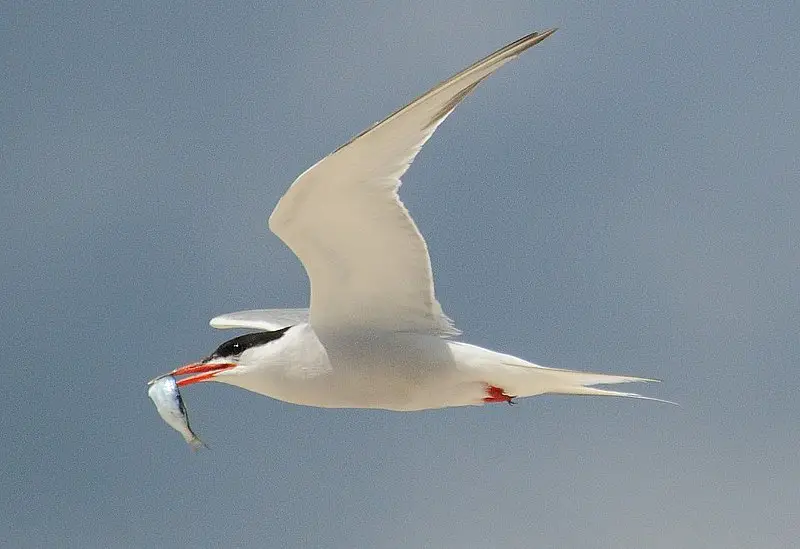
The Common Tern is a seabird in the Laridae family, found all over Europe, Asia and North America. It has a migratory nature, spending its winters in coastal tropical and subtropical regions.
Breeding adults have light grey upperparts with white to very light grey underparts featuring an orange-red beak and black cap.
They are known for their graceful flight as they hunt small fish or insects by diving into water from great heights.
During breeding season they build nests together on islands or sandbars using grasses and other materials to create them.
The female will lay two eggs which she incubates while her mate stands guard nearby; both parents take turns feeding the chicks until it’s time for them fly away.Scientific classification:
| Kingdom | Animalia |
| Phylum | Chordata |
| Class | Aves |
| Order | Charadriiformes |
| Family | Laridae |
| Genus | Sterna |
| Species | S. hirundo |
2. Arctic Tern
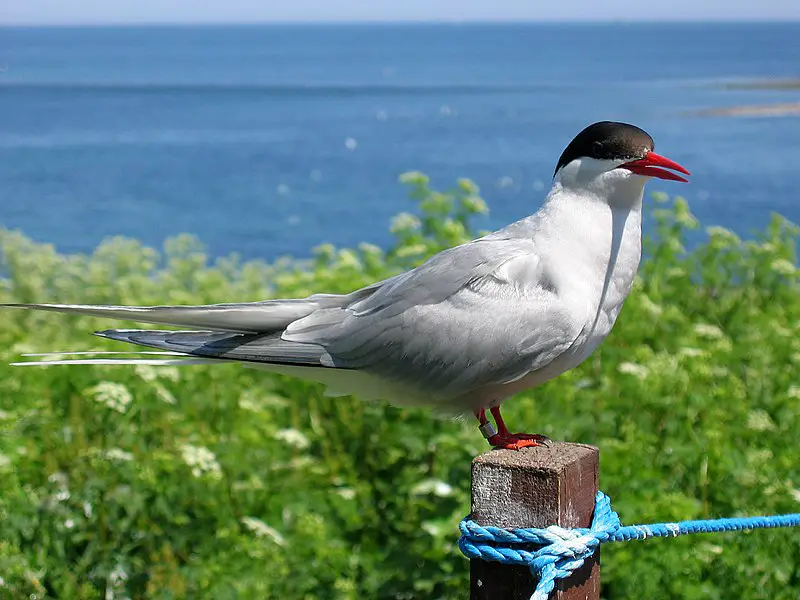
The Arctic tern is an incredible bird that displays a truly remarkable migratory behavior.
It breeds in the northern regions of Europe, Asia and North America during summer before undertaking its migration along a convoluted route to reach the Antarctic for winter.
This species has adapted extremely well to its environment – it can fly very long distances while navigating with ease thanks to their excellent eyesight.
Furthermore, they are able to survive in temperatures as low as -40 degrees Celsius.
The Arctic Tern is also known for being one of the longest living birds on Earth; some have been recorded living up to 30 years old.Scientific classification:
| Kingdom | Animalia |
| Phylum | Chordata |
| Class | Aves |
| Order | Charadriiformes |
| Family | Laridae |
| Genus | Sterna |
| Species | S. paradisaea |
3. Roseate Tern
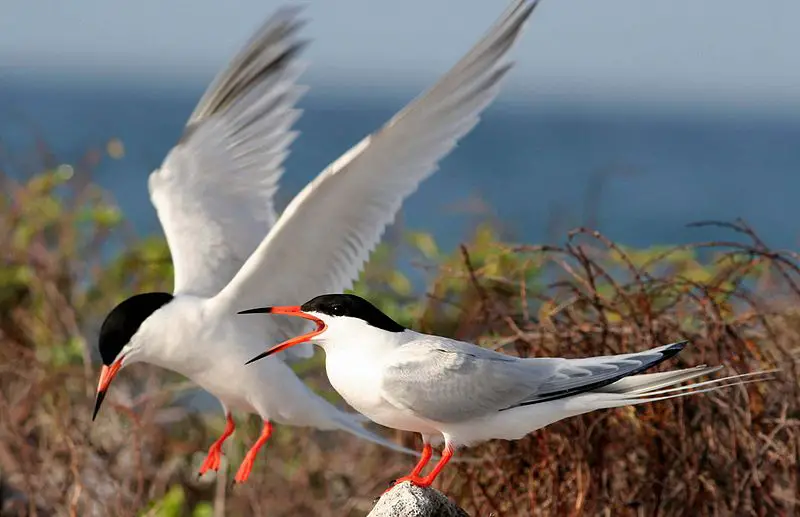
The Roseate Tern (Sterna dougallii) is a species of bird that belongs to the family Laridae. It gets its name from its pink breast in breeding plumage, which gives it a “roseate” appearance.
The genus Sterna comes from Old English and means “tern” while the specific dougallii refers to Scottish physician and collector Dr Peter McDougall (1777–1814).
This species was first described by George Montagu in 1813.
They are most common near coasts but can be found further inland occasionally too. These birds mainly feed on small fish like sardines, anchovies or herring as well as crustaceans when available.
They typically lay two eggs each year during their breeding season between May-September before migrating south for winter months.Scientific classification:
| Kingdom | Animalia |
| Phylum | Chordata |
| Class | Aves |
| Order | Charadriiformes |
| Family | Laridae |
| Genus | Sterna |
| Species | S. dougallii |
4. Least Tern

The Least Tern is a species of tern native to North America and northern South America. It has many close relatives, such as the yellow-billed tern and Peruvian tern from South America, or the little tern from the Old World.
The bird measures 8.7 – 9.4 inches in length with a wingspan of 16–18 inches acrosss, making it an intermediate size between most other species of birds within its family groupings.
Its feathers are usually gray on top with white underneath and typically have darker accents near their heads along with bright red bills for feeding during summer months when they mate upon beaches found throughout these regions mentioned above.
They feed mainly on small fish that live at shallow depths near shorelines where they also nest nearby due to migratory patterns which take place annually each year.
Hence why this particular bird does not travel far distances away from areas known as home for them over long periods of time like some other types do.Scientific classification:
| Kingdom | Animalia |
| Phylum | Chordata |
| Class | Aves |
| Order | Charadriiformes |
| Family | Laridae |
| Genus | Sternula |
| Species | S. antillarum |
5. Royal Tern
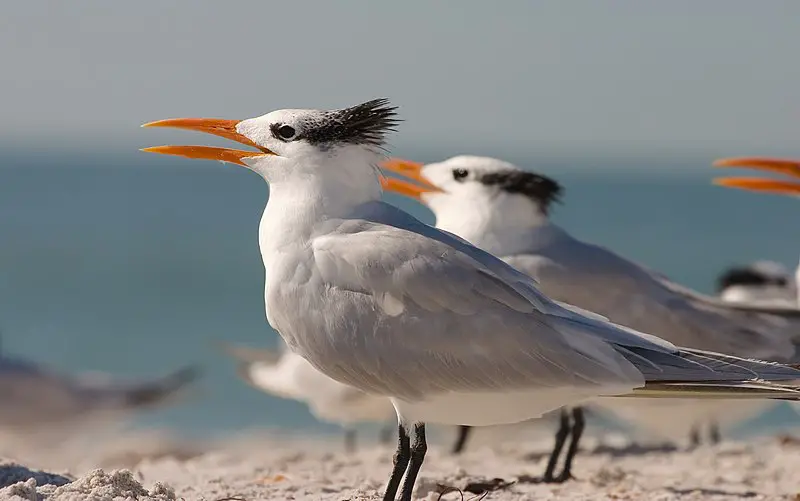
The Royal Tern is a beautiful seabird, endemic to the Americas. It has been spotted as far away as Europe on rare occasions though.
The species was first described by Georges-Louis Leclerc in 1781 from a specimen found in French Guiana and later illustrated with hand-coloured plates.
These birds have elaborate courtship displays that involve loud vocalizations and energetic aerial acrobatics.
They typically mate for life, nesting together near marshes or beaches each season close to their food source of fish and other small aquatic creatures. Their white plumage brightens up coastlines across America – they are truly majestic.Scientific classification:
| Kingdom | Animalia |
| Phylum | Chordata |
| Class | Aves |
| Order | Charadriiformes |
| Family | Laridae |
| Genus | Thalasseus |
| Species | T. maximus |
6. Forster’s Tern
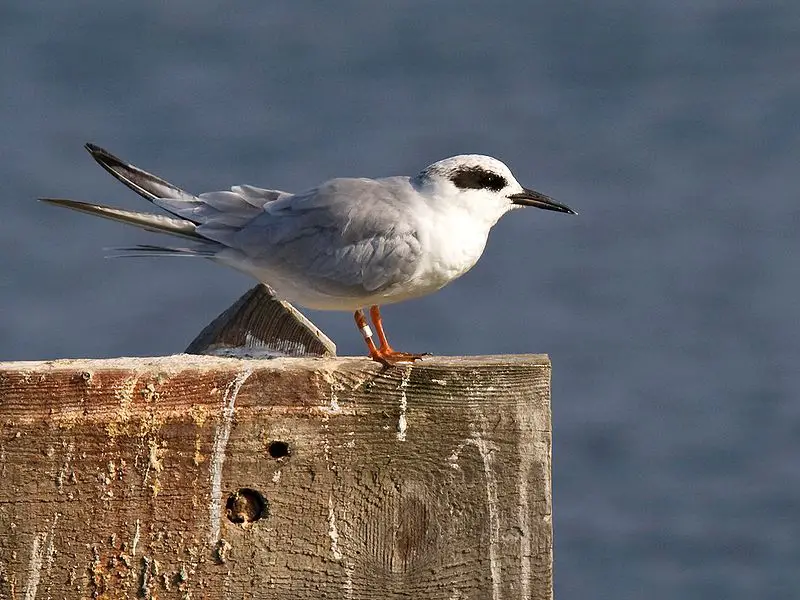
Forster’s tern is a bird of the family Laridae, named after naturalist Johann Reinhold Forster. It mainly breeds in North America and winters south to Central America, though it can also be found rarely but annually in western Europe.
This species has even been documented wintering as far north as Ireland and Great Britain.
The genus name Sterna comes from Old English “stearn”, meaning “tern”.
These birds generally have grey upperparts with white underparts and black heads with a small crest at its forehead that gives it an elegant look when flying around looking for food by diving into the water.Scientific classification:
| Kingdom | Animalia |
| Phylum | Chordata |
| Class | Aves |
| Order | Charadriiformes |
| Family | Laridae |
| Genus | Sterna |
| Species | S. forsteri |
7. Black Tern
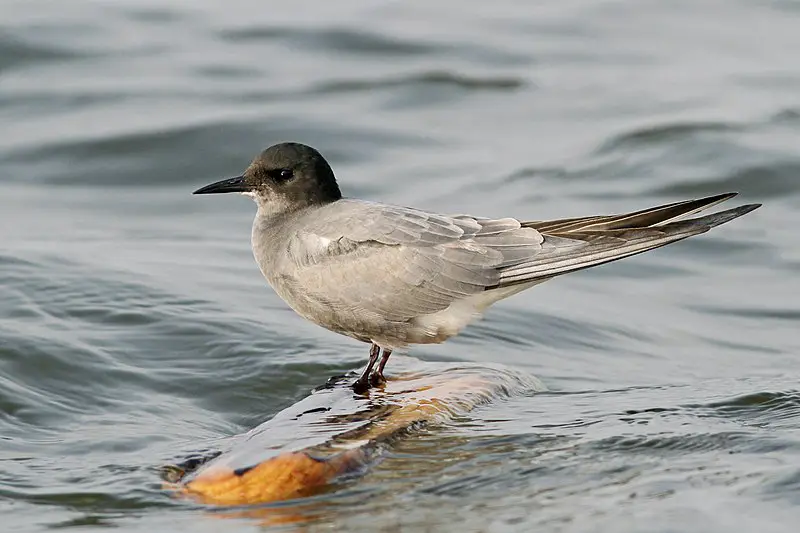
The black tern is a small, yet distinctive bird found in or near inland water habitats throughout Europe, Western Asia and North America.
Its plumage appears darkly coloured from a distance but can shine with an iridescent blue hue up close when breeding season arrives.
It’s name is believed to come from Old English words ‘blue darr’ which references the colour of its feathers in certain lights.
The genus name Chlidonias derives from Greek meaning ‘swallow-like’ due to its similar appearance and behaviour to these birds while fishing for food over shallow waters.
An interesting species, it has made appearances in artwork dating back centuries as well as more recently inspiring music compositions.Scientific classification:
| Kingdom | Animalia |
| Phylum | Chordata |
| Class | Aves |
| Order | Charadriiformes |
| Family | Laridae |
| Genus | Chlidonias |
| Species | C. niger |
8. Sandwich Tern
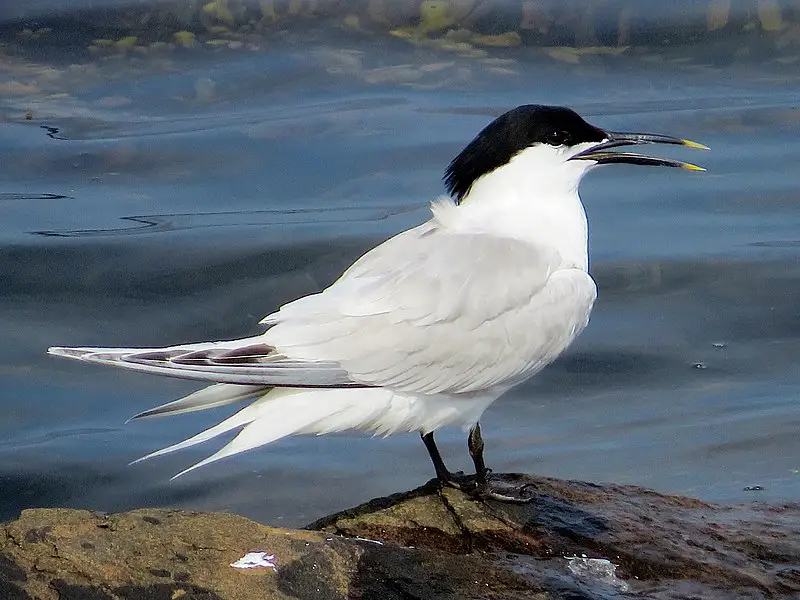
The Sandwich Tern is a medium-sized tern species belonging to the family Laridae. It has close relationships with four other crested terns, and is known to interbreed with the lesser crested.
These birds are distributed throughout Europe and as far east as Caspian Sea in summer, while they migrate south during winter season up to South Africa and India.
They have long wings which help them fly over vast distances effortlessly.
The plumage of these birds consists mainly of greyish tones on its body combined with white head and neck area; whereas it also sports an orange beak along black markings near their eyes – giving them a distinct look from other related species.Scientific classification:
| Kingdom | Animalia |
| Phylum | Chordata |
| Class | Aves |
| Order | Charadriiformes |
| Family | Laridae |
| Genus | Thalasseus |
| Species | T. sandvicensis |
9. Black-Headed Gull
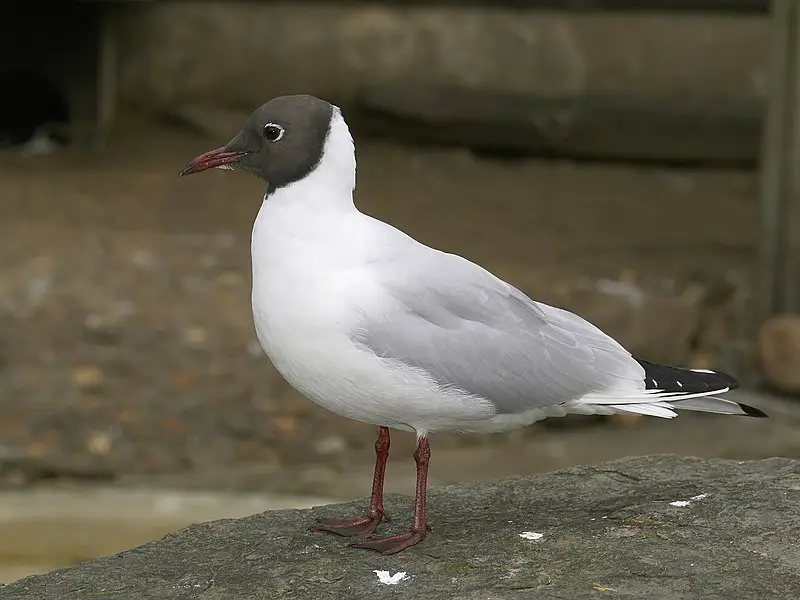
The Black-headed Gull is a small, migratory bird found in much of the Palearctic. It breeds mainly in Europe and coastal eastern Canada but can also be found further west in milder areas.
In North America it’s known as the Common Black-headed Gull.
Its plumage consists of grey on top with white underneath, while its head has a distinctive black cap during breeding season which fades to brown outside of this period.
They are often seen by coastlines or near inland waters where they feed off fish, insects and crustaceans caught either from the surface or underwater depending on their preference at that time.Scientific classification:
| Kingdom | Animalia |
| Phylum | Chordata |
| Class | Aves |
| Order | Charadriiformes |
| Family | Laridae |
| Genus | Chroicocephalus |
| Species | C. ridibundus |
10. Elegant Tern
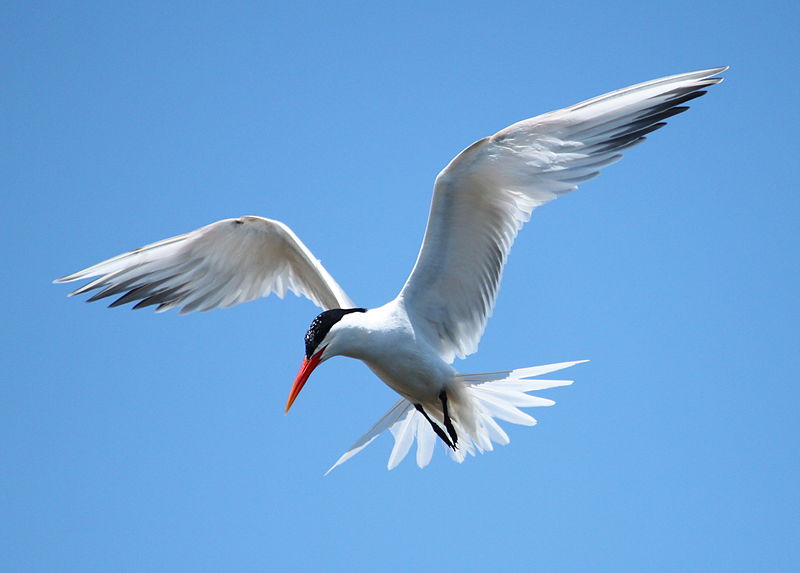
The elegant tern is a captivating species of bird found in the family Laridae. It breeds along the Pacific coasts of Southern United States and Mexico, but during winter it migrates south to Peru, Ecuador and Chile.
This species prefers nesting in dense colonies on coastal islands or exceptionally large freshwater lakes near the coast.
Isla Rasa and Montague Island are some notable examples where they can be seen breeding seasonally.
They have an impressive wingspan that ranges from 80-95 cm with a black cap extending down their neck up to half way down its chest; above which there’s white plumage throughout its body including greyish tones at certain spots thus giving them an alluring appearance.Scientific classification:
| Kingdom | Animalia |
| Phylum | Chordata |
| Class | Aves |
| Order | Charadriiformes |
| Family | Laridae |
| Genus | Thalasseus |
| Species | T. elegans |
Also Featured In: Birds that Live in Jalisco Birds,
11. Gull-Billed Tern
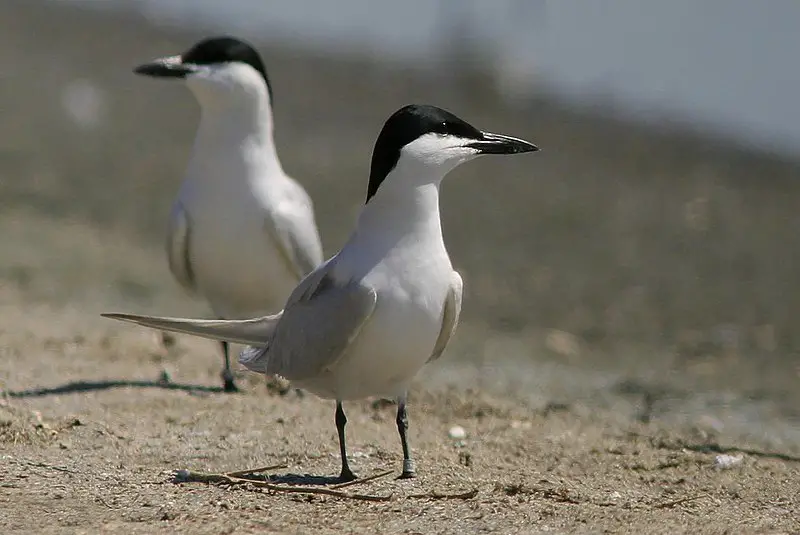
The Gull-billed Tern is a species of seabird from the Laridae family. It has an extensive range, breeding in parts of Europe, Asia, Northwest Africa and North America.
It was formally described by Johann Friedrich Gmelin in 1789 as Sterna nilotica before being reclassified to Gelochelidon nilotica.
The Australian subspecies was previously considered separate but now included with this species.
They are quite small birds measuring around 24 cm long with greyish brown upperparts throughout their body and white underneaths along with black legs and feet.
Their head also features a distinctive yellow bill which they use to hunt for fish on rivers or coasts near shallow waters where they tend to nest during summer months on ground level instead of trees like other terns do usually.Scientific classification:
| Kingdom | Animalia |
| Phylum | Chordata |
| Class | Aves |
| Order | Charadriiformes |
| Family | Laridae |
| Genus | Gelochelidon |
| Species | G. nilotica |
12. Sooty Tern
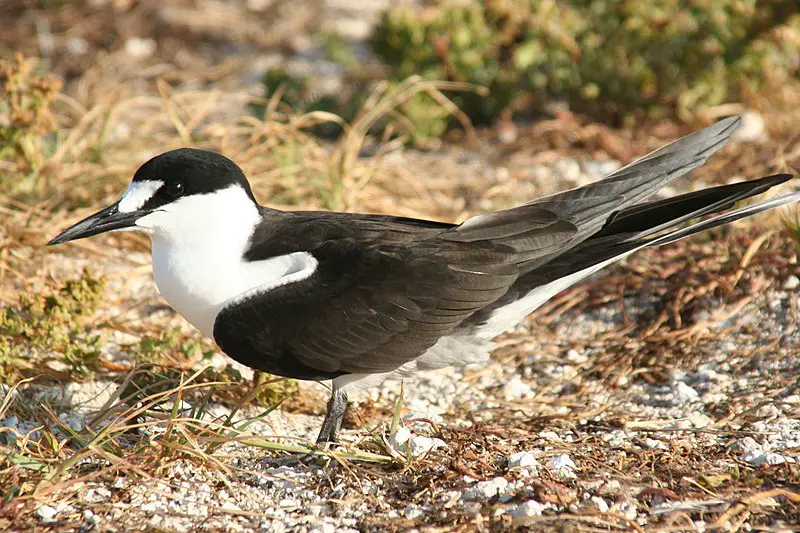
The Sooty Tern is a bird that lives in the tropics of all three major oceans. It is found mostly on remote islands where it returns to nest and breed during its seasonal journeys.
This member of the Laridae family has been described by Carl Linnaeus as Sterna fuscata, though more recently it was given its current name Onychoprion fuscatus.
The sooty tern has dark grey wings and back, with white underneath for camouflage against predators when flying over open ocean waters; they are also adept at diving underwater in search of food such as fish or crustaceans which make up their diet.
They live in colonies and usually lay two eggs each year which incubate for about four weeks before hatching into fluffy little chicks.Scientific classification:
| Kingdom | Animalia |
| Phylum | Chordata |
| Class | Aves |
| Order | Charadriiformes |
| Family | Laridae |
| Genus | Onychoprion |
| Species | O. fuscatus |
13. European Herring Gull
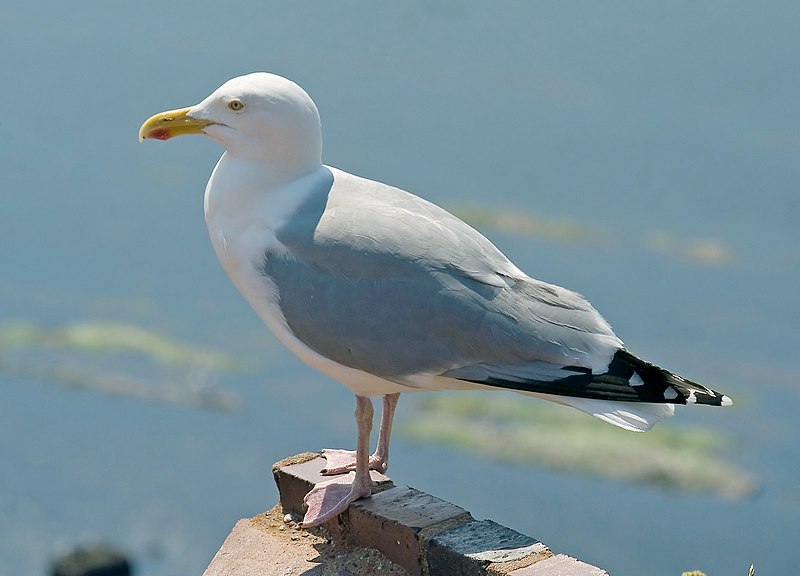
The European herring gull is one of the most recognizable birds, easily spotted along the shorelines of Western Europe.
It has a wingspan up to 66 cm long and can be found nesting across Northern Europe, Central Europe, Eastern Europe and Scandinavia.
During colder months many European herring gulls migrate further south in search for warmer temperatures which allows them to survive better during wintertime.
As scavengers they often take advantage of human debris or waste as food sources near populated areas such as beaches, parks and cities; however their diet also consists on fish, insects and other small animals that live nearby coastal regions.
Despite being common in some parts of its range this species may have experienced population declines due to habitat loss caused by human activities like urbanization but still remains abundant in others thanks to conservation efforts implemented over time by local authorities all around the world.Scientific classification:
| Kingdom | Animalia |
| Phylum | Chordata |
| Class | Aves |
| Order | Charadriiformes |
| Family | Laridae |
| Genus | Larus |
| Species | L. argentatus |
14. Little Tern
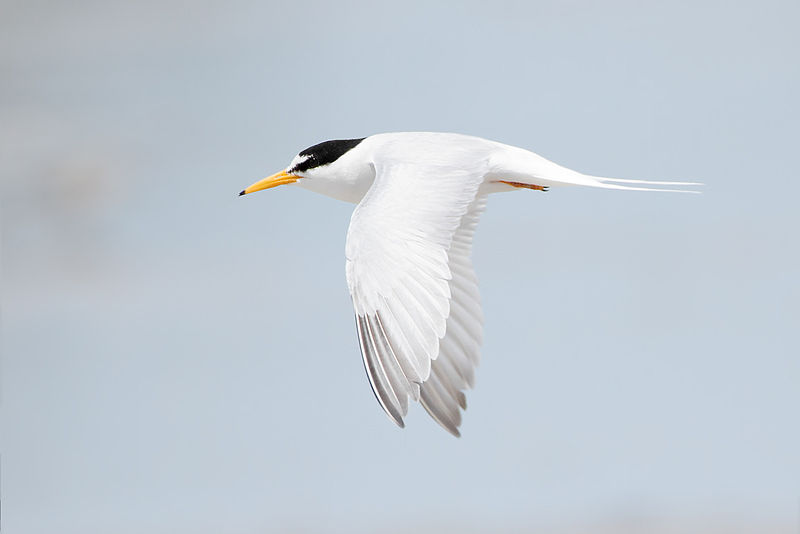
The Little Tern is a delightful seabird belonging to the Laridae family. It has white feathers, with a bright yellow bill and black legs. The species name ‘albifrons’ comes from Latin, meaning “white” and “forehead”.
Formerly they were placed in the genus Sterna which contains large white terns – hence their diminutive size. They can be found around coastal areas of Europe, North America (S.a antillarum) and Red Sea (S.a saundersi).
These birds are known for their graceful flight as they soar above both inland wetlands and marine waters looking for fish to feed on.
Their population numbers have been decreasing due to human impacts such as overfishing so we need to take care that these beautiful creatures continue thriving within our ecosystems.Scientific classification:
| Kingdom | Animalia |
| Phylum | Chordata |
| Class | Aves |
| Order | Charadriiformes |
| Family | Laridae |
| Genus | Sternula |
| Species | S. albifrons |
15. Common Gull
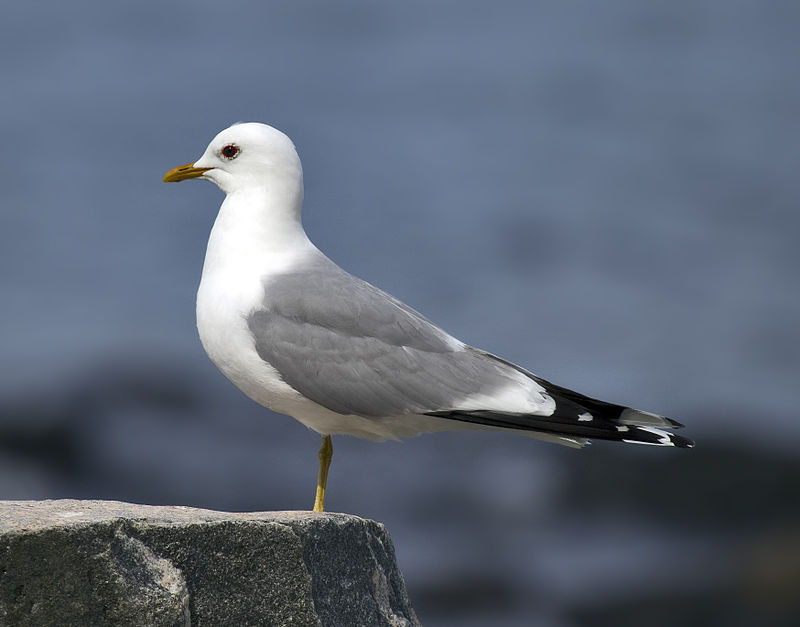
The Common Gull, also known as the Sea Mew, is a medium-sized bird native to northern Europe. It’s closely related to the Short-Billed Gull and both species are sometimes referred to collectively as “Mew Gull”.
During winter months many Common Gulls migrate further south in search of warmer climates.
The exact origin of its vernacular name remains uncertain but it may have something to do with its call which resembles that of a cat meowing.
Its plumage consists mostly of grey and white feathers along with black wingtips making it easily identifiable amongst other gull species.Scientific classification:
| Kingdom | Animalia |
| Phylum | Chordata |
| Class | Aves |
| Order | Charadriiformes |
| Family | Laridae |
| Genus | Larus |
| Species | L. canus |
16. Aleutian Tern
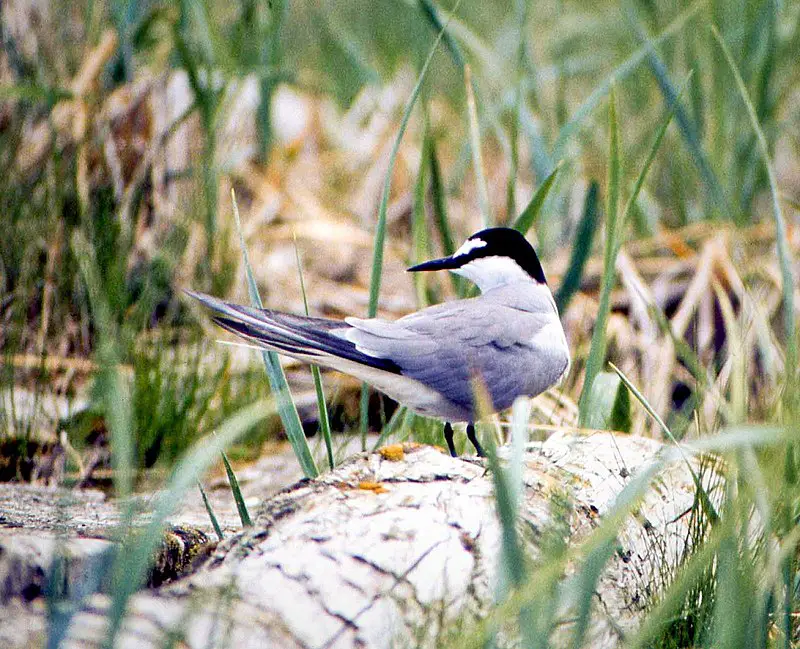
The Aleutian Tern is a migratory bird found in the subarctic region of our planet. It looks very similar to its cousin, the Arctic Tern, with whom it shares a black cap; however, one can distinguish an Aleutian by its white forehead.
During breeding season they may also be identified by their orange bill and feet instead of red like those seen on Arctic terns.
This species feeds mainly on small fish which it fishes from surface waters while flying low over them or diving into shallow water.
They breed mostly along rocky coasts but sometimes build nests inland as well where there are suitable wetlands for raising young chicks.
The population size is unknown but believed to be stable overall making this beautiful seabird safe for now.Scientific classification:
| Kingdom | Animalia |
| Phylum | Chordata |
| Class | Aves |
| Order | Charadriiformes |
| Family | Laridae |
| Genus | Onychoprion |
| Species | O. aleuticus |
17. South American Tern
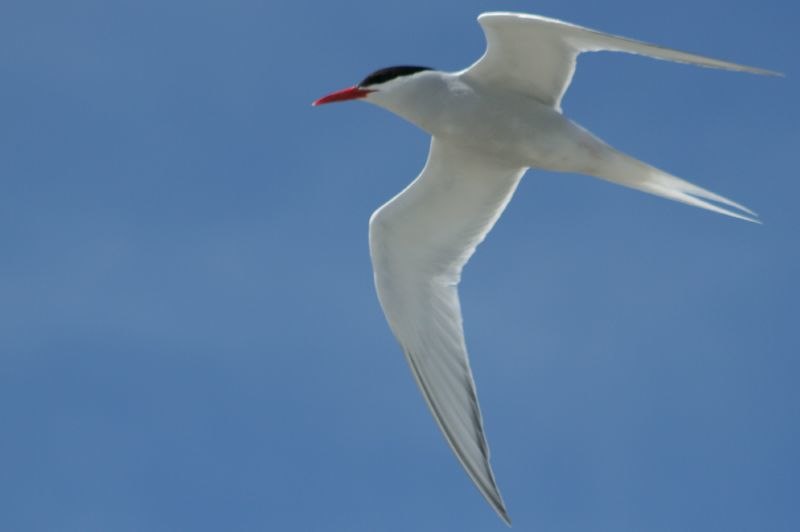
The South American tern is a species of seabird found in coastal regions stretching from the Falklands to Peru and Brazil.
True to its name, this bird has a swallow-like forked tail that helps it soar through the sky with ease.
It also has an impressive wingspan, making it quite easy to spot when flying overhead.
The most distinguishing characteristic of these birds is their bright yellow beak and feet which contrast against their white head and grey body plumage.
They are considered one of the most common terns in their range due to their adaptability across different habitats such as mudflats and beaches or even grassy areas near riversides or lakeshores.
While they usually reside close enough inland so as not to come into contact with humans directly, they can often be seen soaring high above our heads on sunny days.Scientific classification:
| Kingdom | Animalia |
| Phylum | Chordata |
| Class | Aves |
| Order | Charadriiformes |
| Family | Laridae |
| Genus | Sterna |
| Species | S. hirundinacea |
18. Western Gull
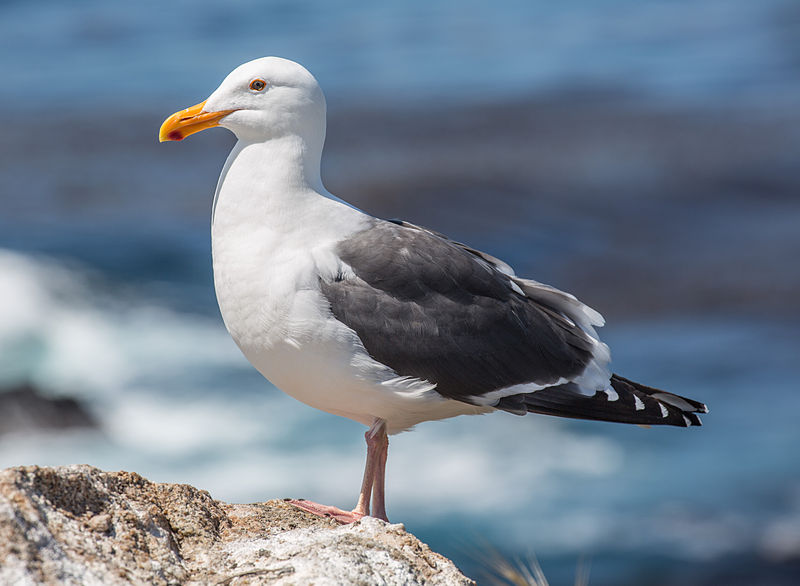
The Western Gull is a majestic seabird found on the West Coast of North America, ranging from British Columbia to Baja California. It has a large white head and stands between 22-27 inches in size.
Its upper parts are gray while its underparts range from brownish grey to white depending on age or sex of the bird.
The most distinguishing feature is its yellow feet which set it apart from other gulls in the area such as Larus livens.
These birds feed by scavenging for food including fish, mollusks, crustaceans and even carrion when available.
They also nest near ocean shores with their eggs hatching anywhere within 28 days after being laid. A beautiful sight to behold at any beach; these birds will surely captivate you with their grandeur.Scientific classification:
| Kingdom | Animalia |
| Phylum | Chordata |
| Class | Aves |
| Order | Charadriiformes |
| Family | Laridae |
| Genus | Larus |
| Species | L. occidentalis |
19. Whiskered Tern
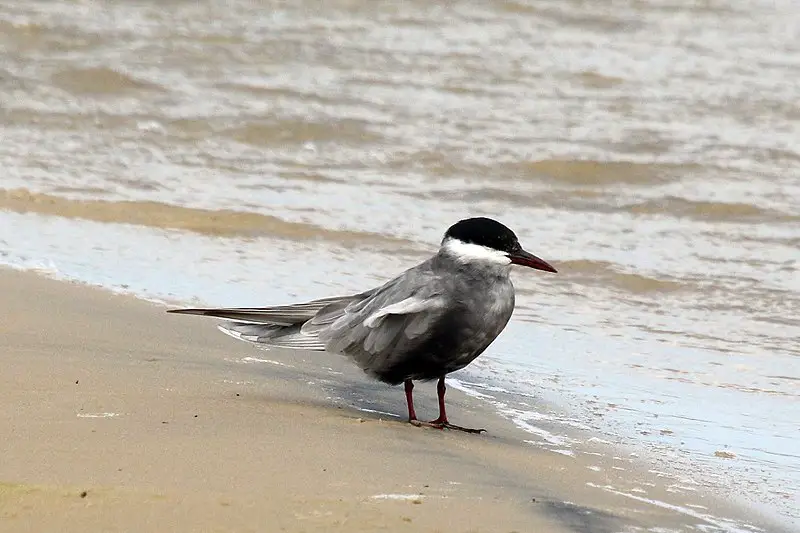
The whiskered tern (Chlidonias hybrida) is a small, graceful bird belonging to the family Laridae, which includes gulls, terns, and skimmers.
This bird is widely distributed across Europe, Asia, and Africa, where it breeds in colonies in freshwater marshes, ponds, and lakeshores.
The whiskered tern has a distinctive appearance, resembling a swallow, with a short, forked tail, black cap, and white cheeks.
One of the most distinctive features of the whiskered tern is its bill, which is strong and pointed. This adaptation allows it to catch insects and small fish, which make up the bulk of its diet.
During the breeding season, the whiskered tern’s bill and legs turn bright red, adding to its striking appearance.
The whiskered tern is a highly adaptable bird, and as such, it is found in various races across its range. For example, in Europe, it breeds mainly in western and southern countries, while in Asia, it breeds from the Middle East to the Russian Far East.
The whiskered tern is also a migrant bird, with populations wintering in sub-Saharan Africa, India, Southeast Asia, and Australia.
Breeding season for the whiskered tern is between May and August, and the birds form colonies with hundreds or thousands of individuals. They build their nests on floating vegetation or on the ground, and both sexes share incubation duties.
The chicks hatch after about three weeks, and the parents feed them insects and small fish until they are ready to fly after about three more weeks.
Although the whiskered tern is not considered threatened, its populations have declined in some areas, primarily due to habitat loss and degradation.
The destruction of wetlands, pollution, and changes in water levels and quality have all had an impact on the bird’s breeding and feeding grounds.Scientific classification:
| Kingdom | Animalia |
| Phylum | Chordata |
| Class | Aves |
| Order | Charadriiformes |
| Family | Laridae |
| Genus | Chlidonias |
| Species | C. hybrida |
20. White-Winged Tern
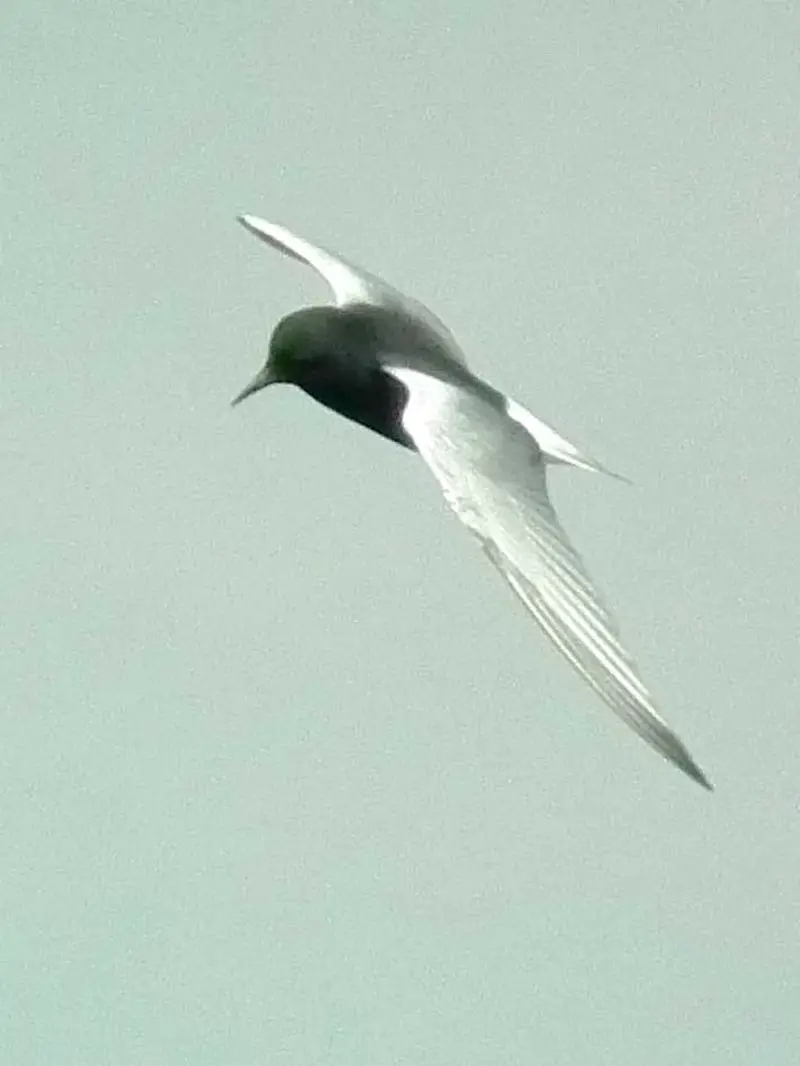
The White-winged Tern is a small species of tern found across much of the world, from Europe to Africa and Asia, inhabiting fresh water habitats.
With its scientific name Chlidonias leucopterus or Chlidonias leucoptera coming from Ancient Greek meaning ‘swallow-like’, it has white wings giving it an unmistakable appearance in flight.
It feeds on insects by swooping down over water surfaces at high speed and snatching them up with its beak while skimming the surface.
This bird also nests near bodies of freshwater such as lakes, rivers and marshes making use of reeds for cover against predators when they’re raising their chicks.
A beautiful sight to behold wherever they are found.Scientific classification:
| Kingdom | Animalia |
| Phylum | Chordata |
| Class | Aves |
| Order | Charadriiformes |
| Family | Laridae |
| Genus | Chlidonias |
| Species | C. leucopterus |
21. Large-Billed Tern
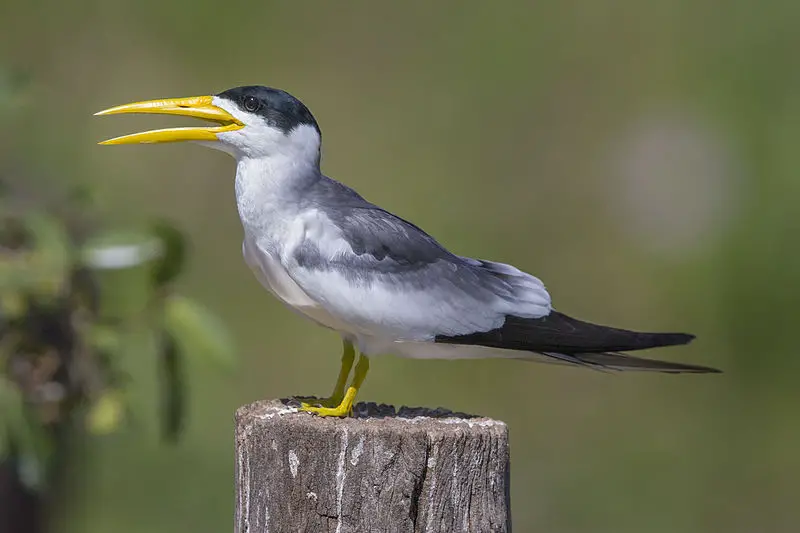
The Large-billed Tern is a species of tern found in most parts of South America. It was formally described by scientists back in 1786 and can be identified for its large bill, which it uses to feed on small fish or insects near rivers or freshwater lakes.
This bird has also been spotted as a vagrant in other countries such as Aruba, Bermuda, Cuba, Panama and the United States.
The Large-Billed Tern prefers shallow waters with plenty of vegetation around them so that they can find food easily while still providing themselves protection from larger predators.
They are quite adept at fishing using their long bills to catch prey but will also scavenge when needed.
In conclusion the Large-billed Tern is an interesting bird who plays an important role within its natural habitat.Scientific classification:
| Kingdom | Animalia |
| Phylum | Chordata |
| Class | Aves |
| Order | Charadriiformes |
| Family | Laridae |
| Genus | Phaetusa Wagler, 1832 |
| Species | P. simplex |
22. Great Black-Backed Gull
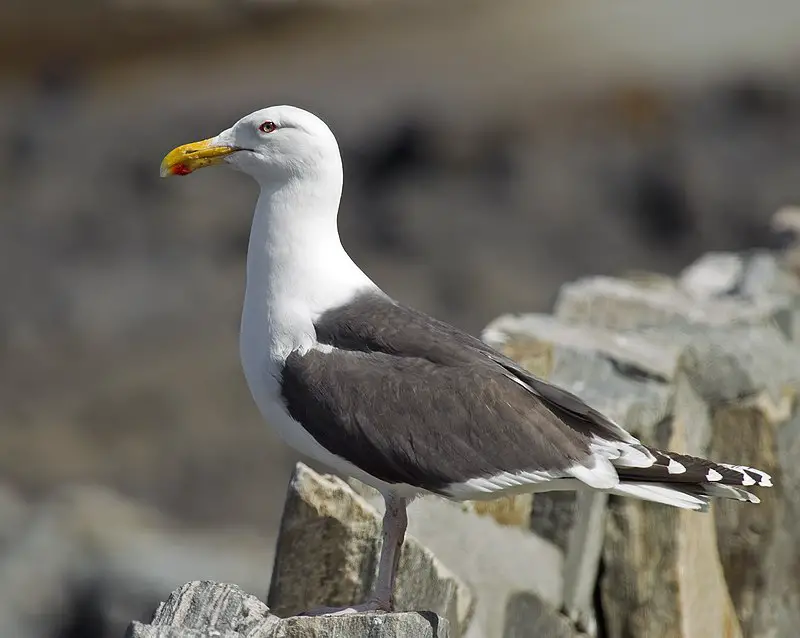
The Great Black-Backed Gull is the largest member of its family and aptly named as “king of the Atlantic waterfront”.
It can be found on both European and North American coasts, islands in the North Atlantic, or farther inland near large lakes.
This seabird is an aggressive hunter with a tendency to scavenge for food that it may not have caught itself.
In addition to their formidable hunting skills they are also adept at stealing from other birds who have successfully managed to catch something themselves.
As such they are known for being very territorial when defending their nests during mating season.
The powerful wingspan of this majestic species make them able to soar through even strong winds but still remain graceful while doing so.
All these characteristics combined show why great black-backed gulls truly live up to their name as kings among seafaring birds.Scientific classification:
| Kingdom | Animalia |
| Phylum | Chordata |
| Class | Aves |
| Order | Charadriiformes |
| Family | Laridae |
| Genus | Larus |
| Species | L. marinus |
23. Bridled Tern
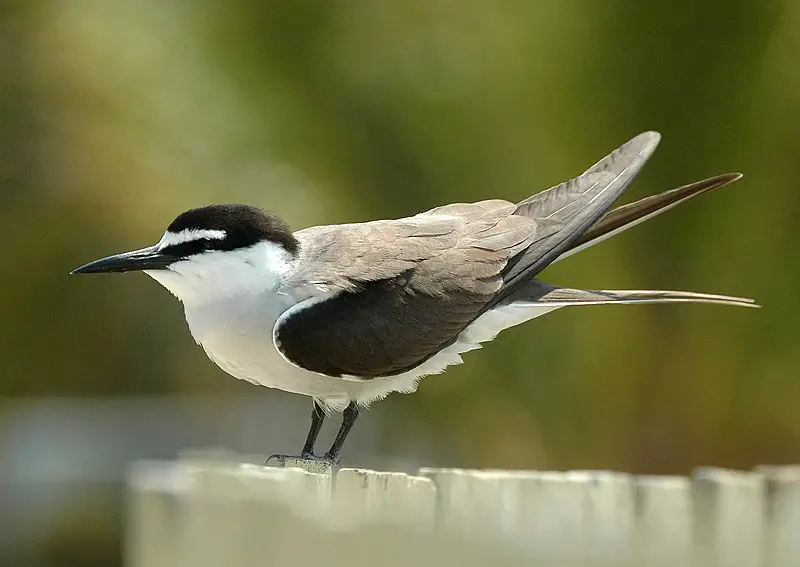
The Bridled Tern is a medium-sized seabird of the family Laridae, found in tropical oceans. It has an impressive wingspan of 77–81 cm and measures 30–32 cm in length – similar to that of the Common Tern.
Its scientific name originates from Ancient Greek; Onux meaning “claw” or “nail”, and Prion, which translates as “saw”. The specific anaethetus means ‘senseless’ or ‘stupid’.
These birds are elegant flyers with greyish brown upperparts and white underparts when they take off into flight, while their head appears black on top but turns to white below the eyes with a thin line between them.Scientific classification:
| Kingdom | Animalia |
| Phylum | Chordata |
| Class | Aves |
| Order | Charadriiformes |
| Family | Laridae |
| Genus | Onychoprion |
| Species | O. anaethetus |
24. Brown Noddy
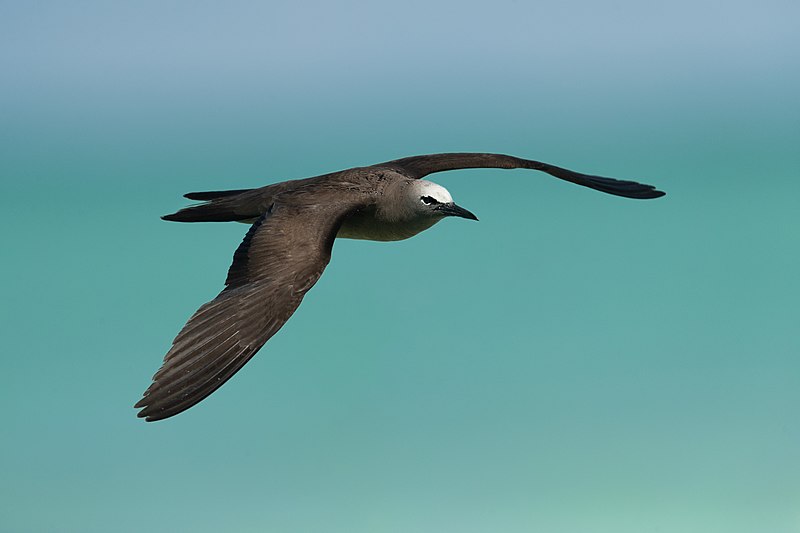
The Brown Noddy is a species of seabird in the Laridae family. It’s the largest of its kind, and can be distinguished from others by its dark brown plumage, which stands out compared to other noddies with black feathers.
Found around tropical oceans worldwide, it inhabits areas such as Hawaii and Australia all the way to Tuamotu Archipelago in Polynesia.
During breeding season they form large colonies on remote islands where their nests are constructed using twigs and leaves situated atop trees or shrubs – typically located near water sources like lagoons or estuaries so they have access to food items like small fish and squid that make up their diet.
As highly social birds they often engage in synchronised flying displays over nesting sites before returning back home at nightfall.Scientific classification:
| Kingdom | Animalia |
| Phylum | Chordata |
| Class | Aves |
| Order | Charadriiformes |
| Family | Laridae |
| Genus | Anous |
| Species | A. stolidus |
25. Greater Crested Tern
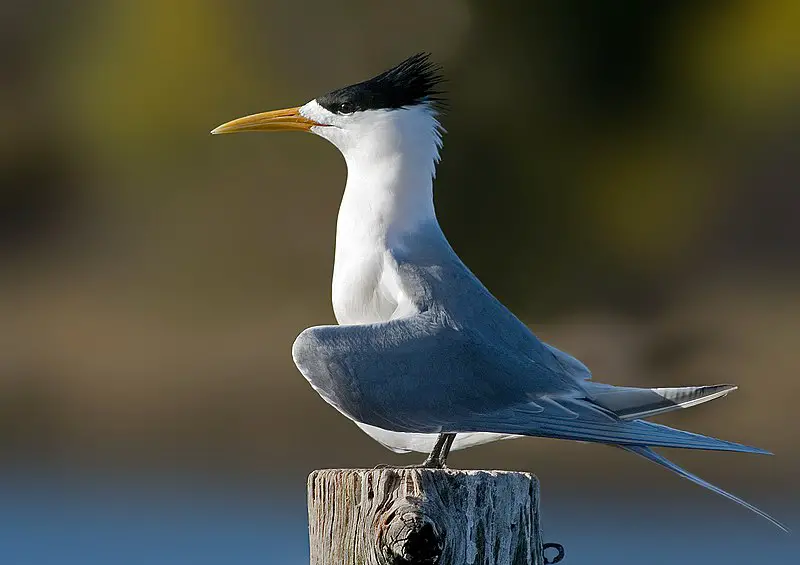
The Greater crested tern is a large bird of the family Laridae, found in tropical and subtropical regions across the Old World.
It has five subspecies which breed from South Africa to Australia, before migrating away for winter.
The distinctive crest feathers on its head give it its name and set it apart from other species like gulls or skuas.
They have wide wingspans that allow them to fly swiftly over oceans or coasts with ease – they are known as swift terns because of this.
The greater crested tern feeds mainly off fish caught at sea by plunge-diving into waters up to 10m deep; an impressive feat indeed.
With their bright white plumage, black caps and long yellow bills they stand out against any landscape – even on land these birds can be seen enjoying life along coastlines.Scientific classification:
| Kingdom | Animalia |
| Phylum | Chordata |
| Class | Aves |
| Order | Charadriiformes |
| Family | Laridae |
| Genus | Thalasseus |
| Species | T. bergii |
26. Lesser Black-Backed Gull
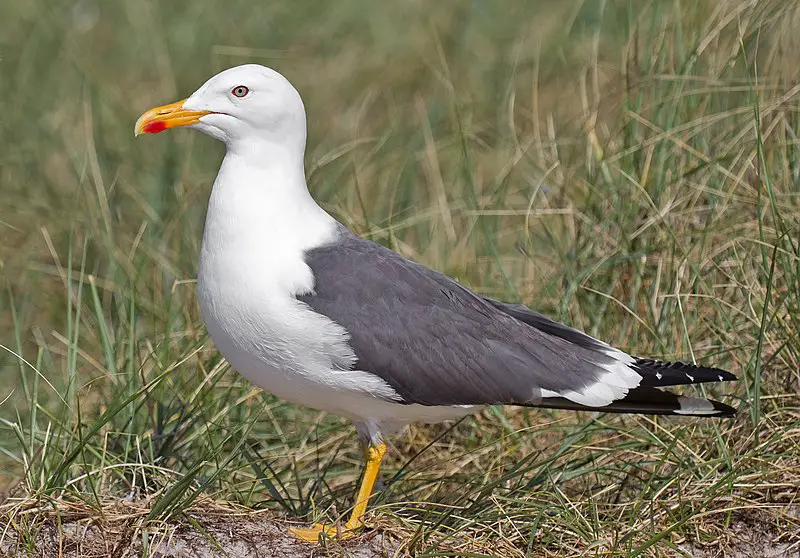
The lesser black-backed gull is a large, migratory bird found along the Atlantic coasts of Europe and North America.
During winter months they are commonly spotted along the British Isles to West Africa while in summer many birds can be seen year-round on both east and west coastlines.
In recent years numbers of these birds have risen dramatically with some winters having great abundances present throughout their range.
They measure around 48cm long with wingspans reaching up to 110 cm across when fully grown – making them larger than most other common gull species.
These hardy seabirds feed mainly on small fish, crustaceans, molluscs as well as carrion or scraps from human activities that occur near coastal areas such as fishing ports or refuse dumpsites.Scientific classification:
| Kingdom | Animalia |
| Phylum | Chordata |
| Class | Aves |
| Order | Charadriiformes |
| Family | Laridae |
| Genus | Larus |
| Species | L. fuscus |
27. Heermann’s Gull
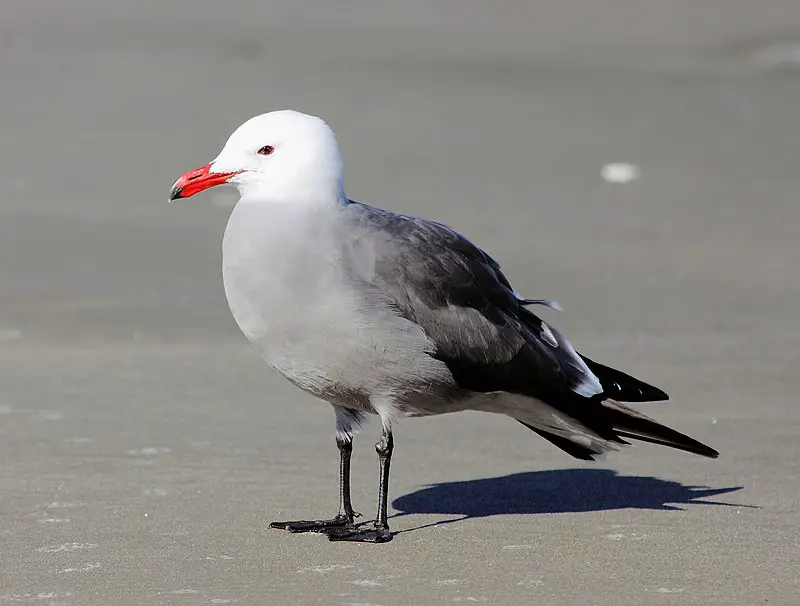
Heermann’s gull is a type of seabird found in the United States, Mexico and British Columbia. It nests on Isla Rasa in the Gulf of California and can be seen near shores or out at sea, though rarely inland.
Named after Adolphus Lewis Heermann, a nineteenth-century explorer and naturalist, this species looks quite different from other gulls due to its brownish colouring with white spots around the wings.
It has bright yellow legs as well as red eyes circled by an orange ring – features that make it easily identifiable among bird watchers.
Their diet consists mainly of fish but they will also eat insects, crustaceans and molluscs if necessary.
Although not considered endangered yet their numbers have been decreasing over time so conservation efforts are imperative for these beautiful birds.Scientific classification:
| Kingdom | Animalia |
| Phylum | Chordata |
| Class | Aves |
| Order | Charadriiformes |
| Family | Laridae |
| Genus | Larus |
| Species | L. heermanni |
28. Chinese Crested Tern
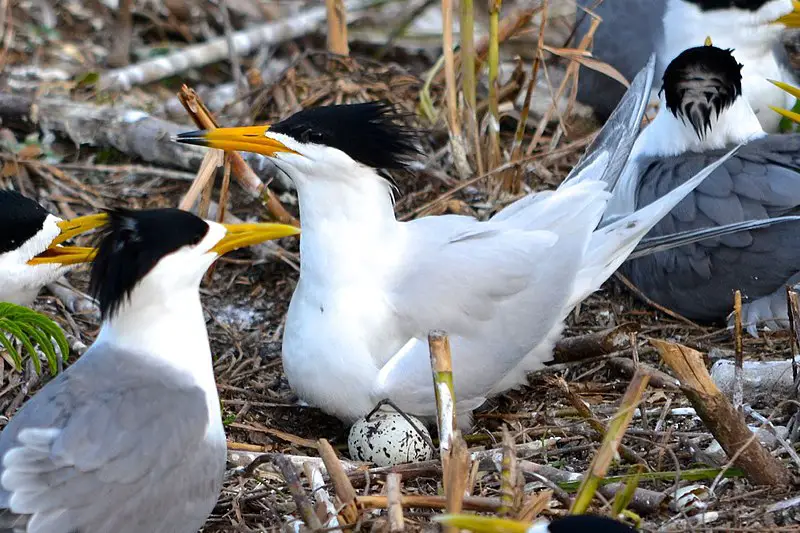
The Chinese crested tern is a beautiful bird with an impressive wingspan. It has black and white plumage, yellow legs and feet, and a distinctive bill pattern – yellow with a thick black tip.
This species is closely related to the Sandwich tern and Lesser Crested Tern but can easily be distinguished by its reversed colouring on its bill.
As the county bird of Lienchiang County in Fuchien province it’s well-known locally for being both hardy and graceful as it glides through the air.
The diet consists mainly of small fish which they catch whilst flying over shallow waters or coastal areas, making them great hunters.
They are also capable of floating just above oceans surfaces using their long narrow wingspans enabling them to spot potential prey below more effectively than other sea birds.
All-in-all these spectacular creatures make wonderful additions to any environment they inhabit.Scientific classification:
| Kingdom | Animalia |
| Phylum | Chordata |
| Class | Aves |
| Order | Charadriiformes |
| Family | Laridae |
| Genus | Thalasseus |
| Species | T. bernsteini |
29. Black-Legged Kittiwake
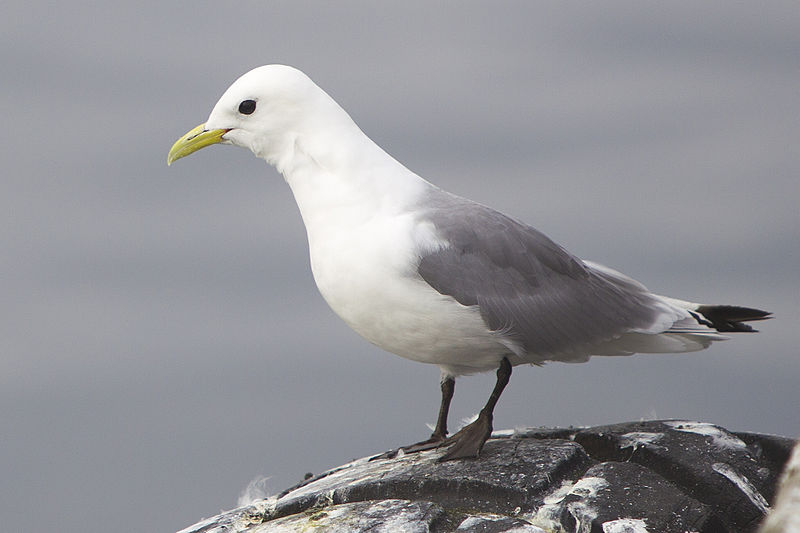
The Black-legged Kittiwake is a seabird of the gull family Laridae. It was first described by Carl Linnaeus in 1758 and its name derives from its distinctive call which sounds like ‘kittee-wa-aaake, kitte-wa-aaake’.
These birds are mainly found along coastal regions with plenty of food sources such as plankton and fish. They have white bodies with slate grey wings and black legs.
The bill is yellowish orange to red depending on age or season.
In winter they migrate southwards away from their northern habitats into warmer waters for breeding purposes before returning again once spring arrives.Scientific classification:
| Kingdom | Animalia |
| Phylum | Chordata |
| Class | Aves |
| Order | Charadriiformes |
| Family | Laridae |
| Genus | Rissa |
| Species | R. tridactyla |
30. Ring-Billed Gull
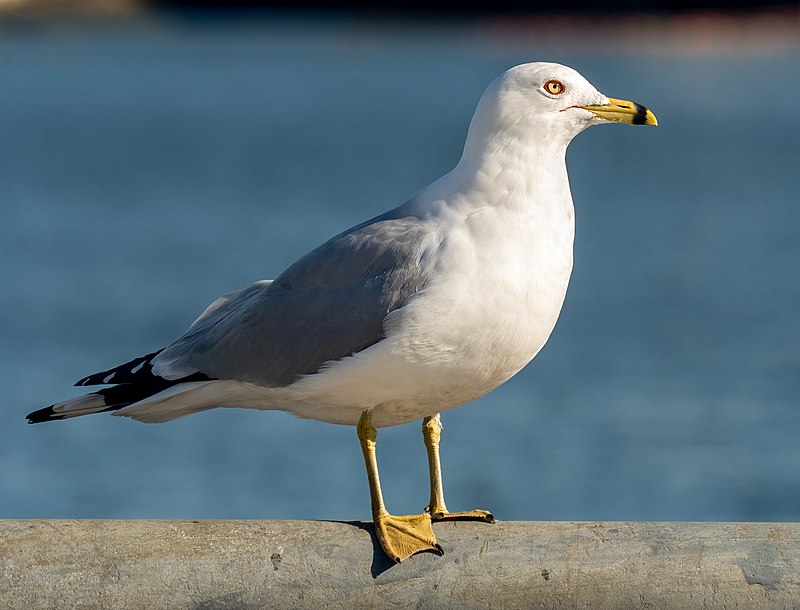
The Ring-billed Gull is a medium sized seabird that can be seen throughout North America. Its head, neck and underparts are white while its back and wings are silver gray in color.
It has a relatively short yellow bill with a dark ring around it, as well as yellow legs.
The genus name for this species of gull comes from the Latin word ‘Larus’ which referred to large sea birds or gulls; while the specific delawarensis refers to the Delaware River where these birds were first discovered.
These beautiful creatures thrive near coasts, lakeshores and other bodies of water but also have been known to inhabit urban areas such as parks close by those watersides due to their adaptability towards human habitats.Scientific classification:
| Kingdom | Animalia |
| Phylum | Chordata |
| Class | Aves |
| Order | Charadriiformes |
| Family | Laridae |
| Genus | Larus |
| Species | L. delawarensis |
31. Antarctic Tern

The Antarctic tern is a seabird in the Laridae family. It inhabits southern oceans, small islands around Antarctica and mainland coasts.
This stocky bird has similar features to its relative Arctic Tern but can be identified by its breeding plumage of white feathers with black markings on head, wings and tail.
Its diet mainly consists of fish, crustaceans and other marine animals which it catches during dives or while hovering over water surface.
The Antarctic terns breed between October-March when they congregate near coastal areas where they can find plenty of food for themselves as well as their young ones.
These birds make impressive long distance travels each year back to the same locations making them true ocean wanderers.Scientific classification:
| Kingdom | Animalia |
| Phylum | Chordata |
| Class | Aves |
| Order | Charadriiformes |
| Family | Laridae |
| Genus | Sterna |
| Species | S. vittata |
32. White Tern
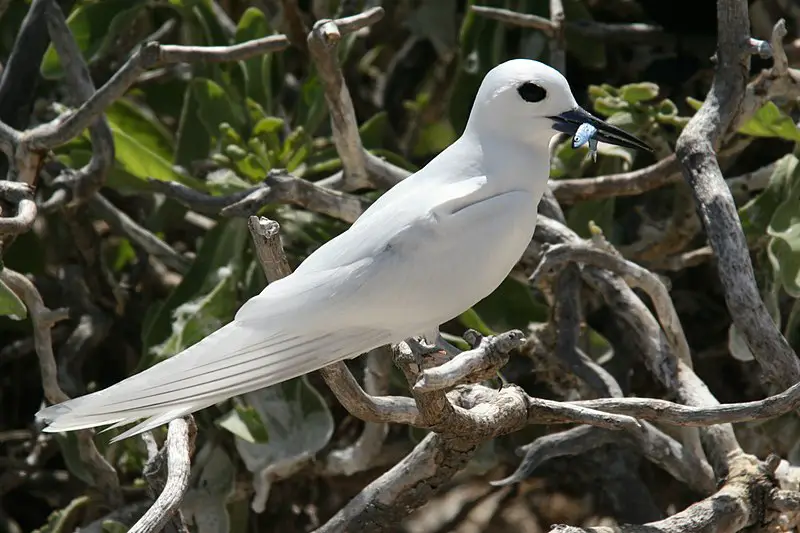
The White tern, also known as the common white tern or Fairy Tern, is a small seabird species found across tropical oceans all over the world.
Known for its elegance and beauty by humans and other animals alike, these birds are truly mesmerizing with their snow-white feathers.
They can be seen soaring in high altitudes or circling around ships at sea looking for food. The Hawaiian name ‘manu-o-Kū’ translates to ‘bird of heaven’ which reflects how majestic this bird looks when it flies through the sky.
These lovely creatures often breed on isolated islands away from predators along with another smaller species called Little White Terns (Gygis microrhyncha).Scientific classification:
| Kingdom | Animalia |
| Phylum | Chordata |
| Class | Aves |
| Order | Charadriiformes |
| Family | Laridae |
| Genus | Gygis |
| Species | G. alba |
33. Lesser Crested Tern
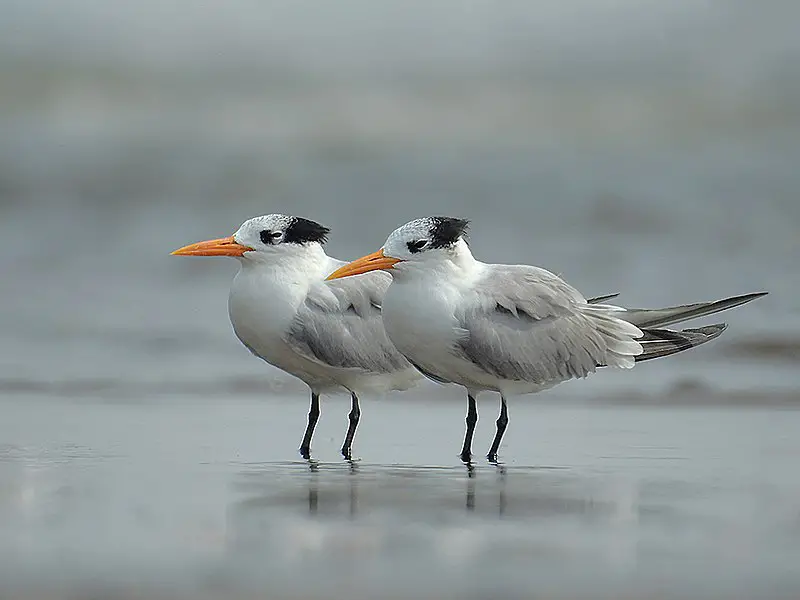
The lesser crested tern is a beautiful bird belonging to the Laridae family. It can be found breeding in subtropical coastal parts of the world, mainly from Red Sea across Indian Ocean.
Its genus name comes from Ancient Greek word Thalasseus which means fisherman and its specific bengalensis refers to Bengal, historically referring to much of northern India and Bangladesh.
The adult has white plumage with grey on wings and back; black cap extending behind eye; long pointed bill yellow tipped red at base, orange legs and feet.
They feed primarily by plunge-diving for fish near shore but may also take some insects or scavenge off boats or piers when given opportunity.
This species nests in colonies often on beaches or islands with other seabirds where it lays two eggs per clutch that are incubated for about a month before hatching.Scientific classification:
| Kingdom | Animalia |
| Phylum | Chordata |
| Class | Aves |
| Order | Charadriiformes |
| Family | Laridae |
| Genus | Thalasseus |
| Species | T. bengalensis |
34. Little Gull
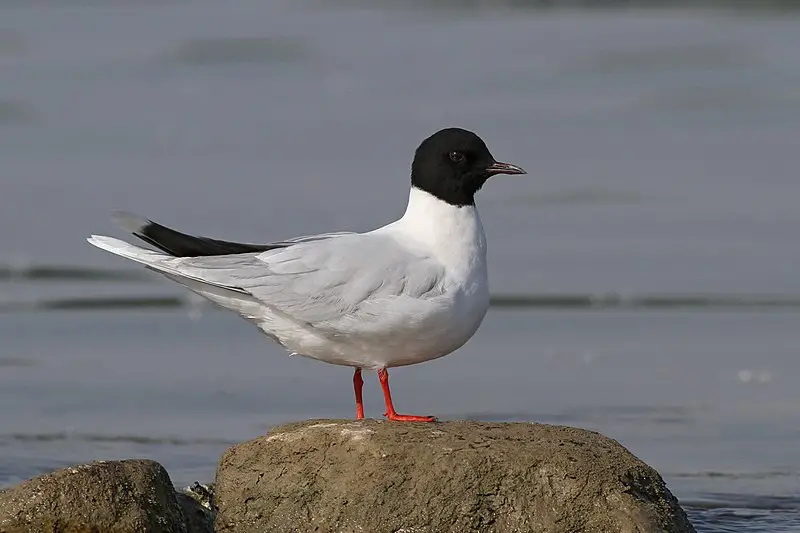
The Little Gull is a small species of gull that can be found breeding in Northern Europe, across the Palearctic and even some parts of Southern Canada. It has a Latin name ‘Hydrocoloeus minutus’ which translates to ‘water bird with webbed feet’.
This migratory bird winters along coastlines in western Europe, the Mediterranean Sea and North Africa. Having grey wings tipped with black spots & white head & underparts this species stands out among other birds.
They also have yellow bills and red legs making them easily recognizable by experienced ornithologists all over the world.Scientific classification:
| Kingdom | Animalia |
| Phylum | Chordata |
| Class | Aves |
| Order | Charadriiformes |
| Family | Laridae |
| Genus | Hydrocoloeus Kaup, 1829 |
| Species | H. minutus |
35. Glaucous Gull
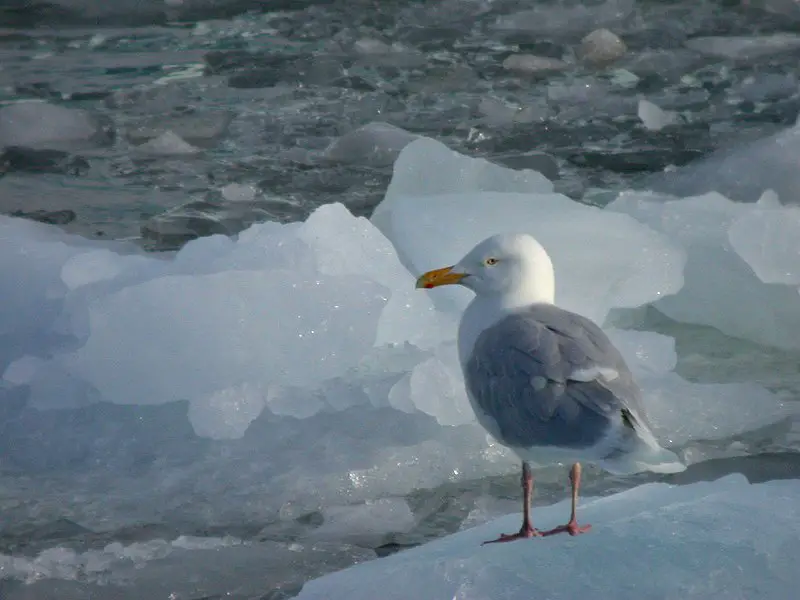
The Glaucous Gull is a majestic species of bird which can be found in the Arctic regions of the Northern Hemisphere.
It has an impressive wingspan, being one of the largest gulls in existence and second only to The Great Black-Backed Gull.
During winter months they migrate southwards towards coasts along Holarctic shores where their presence is seen as far down as South Africa.
Their genus name ‘Larus’, from Latin origins, likely refers to some kind of seabird while its specific name ‘hyperboreus’ derives from Greek for “northern”, referencing Ancient Greeks who lived near what became known as North Pole.
This stunning avian species makes them an unforgettable sight on any journey northward or through coastal areas throughout much of Europe and Asia.Scientific classification:
| Kingdom | Animalia |
| Phylum | Chordata |
| Class | Aves |
| Order | Charadriiformes |
| Family | Laridae |
| Genus | Larus |
| Species | L. hyperboreus |
36. Iceland Gull
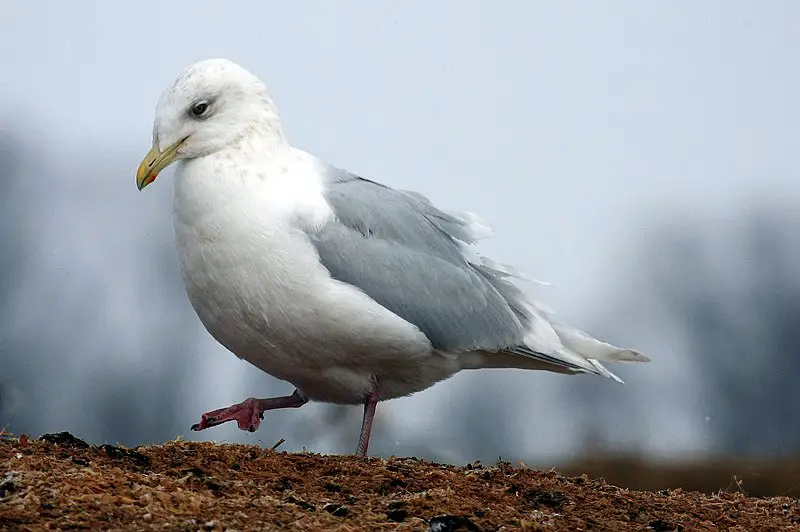
The Iceland Gull is a medium-sized, Arctic-dwelling gull whose range includes Canada and Greenland, but not its namesake.
Its gray wings are marked with black primaries and white tips on the inner secondary feathers which distinguishes it from other similar species like Larus hyperboreus which has completely white secondaries.
It feeds mainly by scavenging or kleptoparasitism – stealing food from other birds – as well as actively pursuing smaller prey such as crustaceans and insects in shallow waters near shorelines.
When breeding season arrives they nest atop rocky outcrops found along coastal areas to provide adequate protection against predators while also giving them an unobstructed view of their surroundings for when danger approaches.
The Iceland Gull can be seen during winter months visiting places like Iceland where temperatures remain more hospitable than its native habitat further north despite the cold weather.Scientific classification:
| Kingdom | Animalia |
| Phylum | Chordata |
| Class | Aves |
| Order | Charadriiformes |
| Family | Laridae |
| Genus | Larus |
| Species | L. glaucoides |
37. White-Fronted Tern
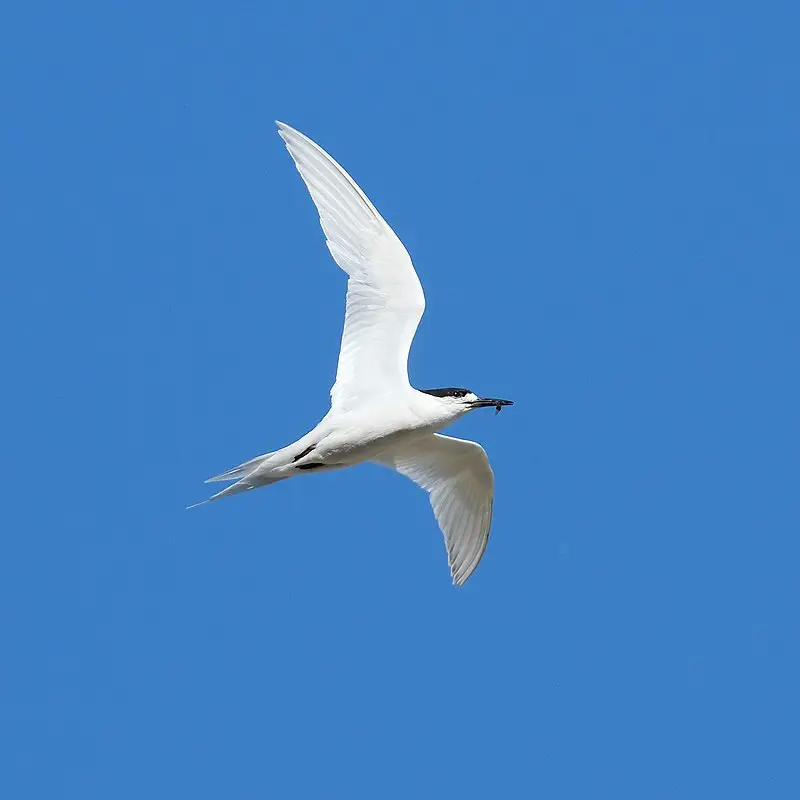
The White-fronted Tern is a medium-sized tern with an all white body and forked tail. Its wings have grey hues on the upper side and underwing.
During breeding season, this species can be distinguished by its striking black cap that covers its head, forehead and nape giving it a unique look.
It was first described by Johann Friedrich Gmelin in 1789 and goes by many names such as ‘tara’, ‘sea swallow’ or ‘swallowtail’.
These birds are commonly seen near coastlines where they hunt small prey like fish, crustaceans and insects over shallow waters.
Their diet also includes rodents which they capture during their migratory flights to more temperate regions during winter months.Scientific classification:
| Kingdom | Animalia |
| Phylum | Chordata |
| Class | Aves |
| Order | Charadriiformes |
| Family | Laridae |
| Genus | Sterna |
| Species | S. striata |
Also Featured In: Birds that Live in Kangaroo Island, Most Common Birds in Stewart Island
38. White-Cheeked Tern
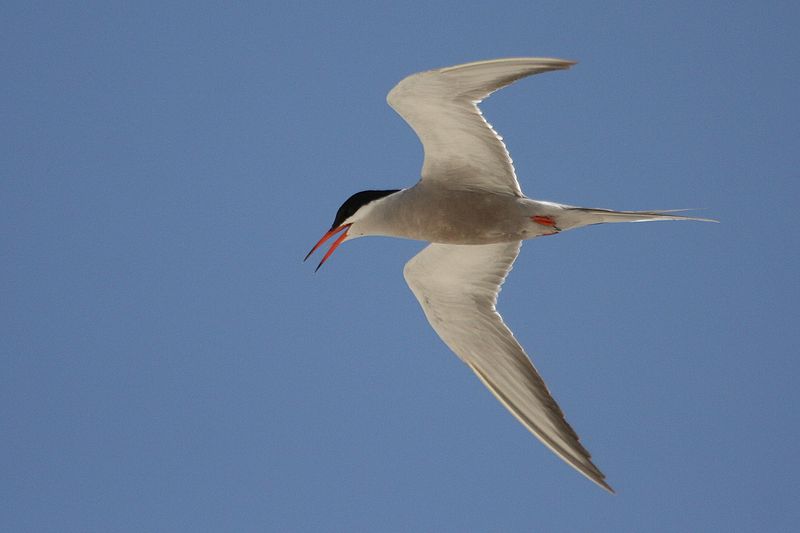
White-cheeked terns are a species of sea birds found along the coasts on the Red Sea, Horn of Africa to Kenya and Persian Gulf. They migrate during winter season with colonies ranging from 10 to 200 pairs.
These birds have white cheeks and grey upperparts which contrast against their black cap, wings and tail feathers.
In addition they possess long pointed bills making them excellent hunters for fish in both fresh or salt water habitats.
Generally solitary outside breeding times they feed using plunge dives into the water while airborne or even swimming if necessary.
During nesting time these terns become more social as parents share incubation duties before fledging young once hatched successfully.Scientific classification:
| Kingdom | Animalia |
| Phylum | Chordata |
| Class | Aves |
| Order | Charadriiformes |
| Family | Laridae |
| Genus | Sterna |
| Species | S. repressa |
39. Black-Naped Tern
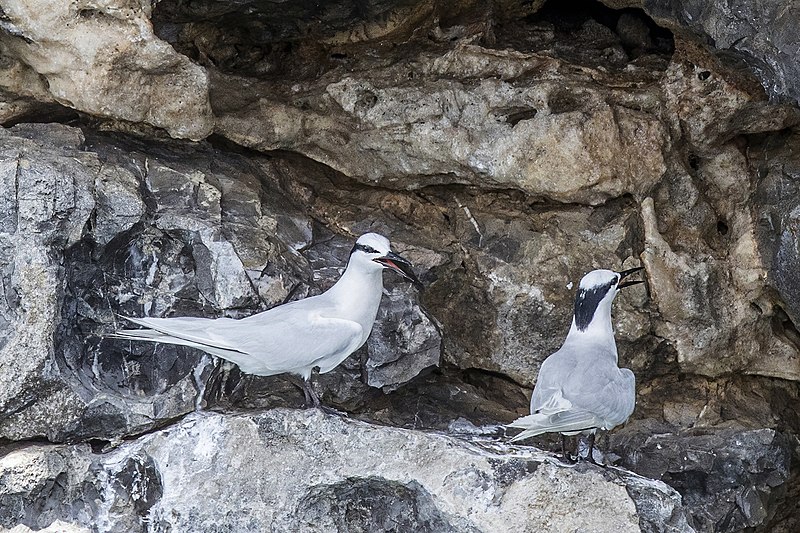
The beautiful Black-naped Tern is a seabird found in tropical and subtropical areas of the Pacific and Indian Oceans.
These terns measure around 30 cm long, with a wing span of 21 to 23 cm, black beaks and legs, yellow bill tips, long forked tails and white faces.
The breast has grayish-white feathers that extend down its back – forming an elegant nape hence their name.
They are rarely seen inland but they can stay close to coastal waters or even venture further out depending on seasonal changes.
Their diet consists mainly of fish which they hunt from above by hovering before plunging into the sea at high speed after prey. They also feed on crustaceans sometimes too.
All in all these birds have an interesting lifestyle; incredibly graceful when airborne yet ferocious hunters underwater making them quite a sight.Scientific classification:
| Kingdom | Animalia |
| Phylum | Chordata |
| Class | Aves |
| Order | Charadriiformes |
| Family | Laridae |
| Genus | Sterna |
| Species | S. sumatrana |
40. Black-Fronted Tern
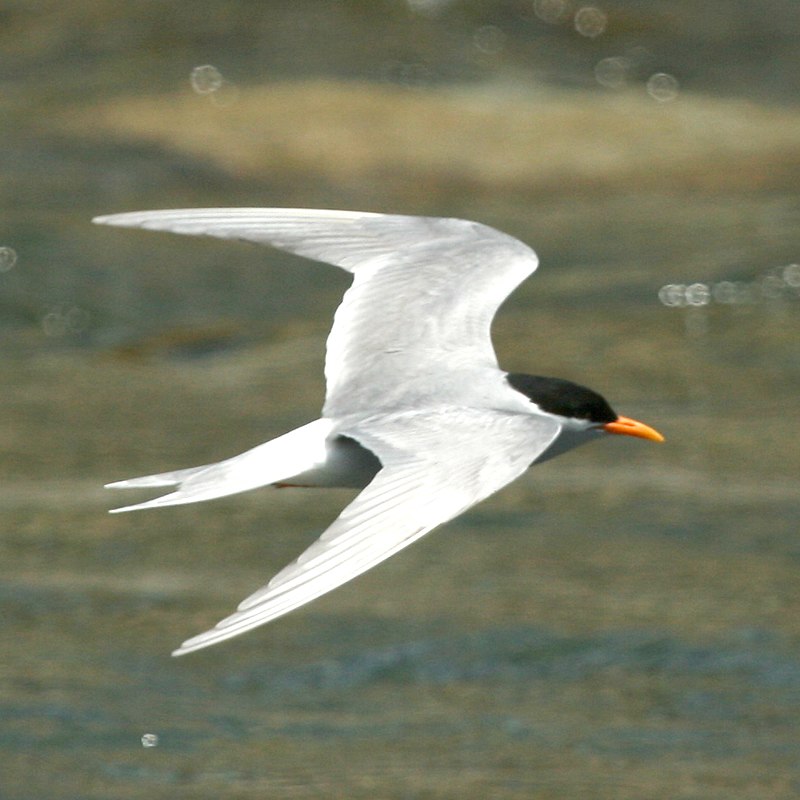
The Black-fronted Tern is a small species of tern found mainly in New Zealand. It has a mostly grey plumage and feeds on freshwater fish, arthropods and worms.
This bird breeds primarily in the eastern regions of the South Island, with its population having declined due to habitat loss over recent years.
The Black-fronted Tern prefers lowland sites near waterbodies such as rivers or lakes for nesting purposes, though it also occurs around coastal areas during migration periods.
Its call is high pitched and distinctive – one that can easily be recognized by experienced birdwatchers. Conservation efforts are underway to protect this unique species from further decline into extinction.Scientific classification:
| Kingdom | Animalia |
| Phylum | Chordata |
| Class | Aves |
| Order | Charadriiformes |
| Family | Laridae |
| Genus | Chlidonias |
| Species | C. albostriatus |
41. Black-Bellied Tern
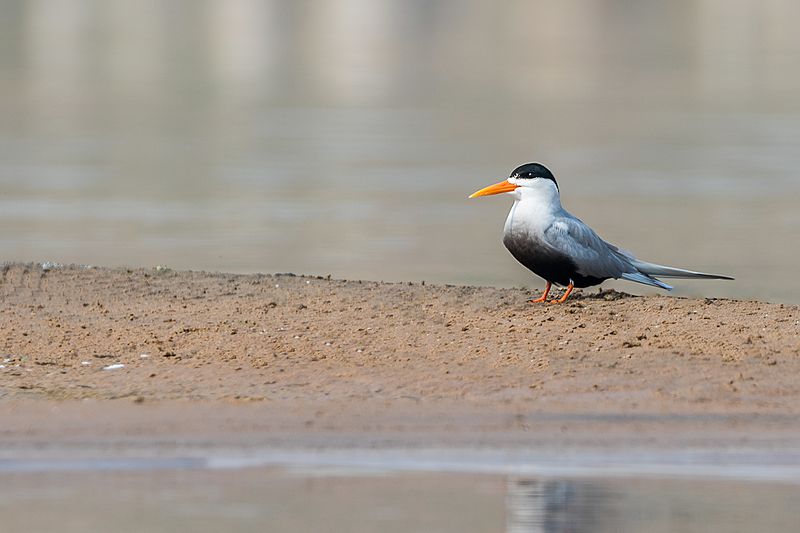
The black-bellied tern is a beautiful bird found in the Indian subcontinent, extending from Pakistan to Myanmar.
It has an elegant forked tail and its feathers come in two distinctive shades – during summer months it boasts a deep black belly which contrasts with its grey upperparts.
Unfortunately this species has become very rare, leading the International Union of Conservation of Nature to classify them as endangered.
They are often seen near large rivers where they fish for small insects and crustaceans. This stunning bird deserves more attention so that conservation measures can be put into place to ensure their future survival.Scientific classification:
| Kingdom | Animalia |
| Phylum | Chordata |
| Class | Aves |
| Order | Charadriiformes |
| Family | Laridae |
| Genus | Sterna |
| Species | S. acuticauda |
42. Laughing Gull
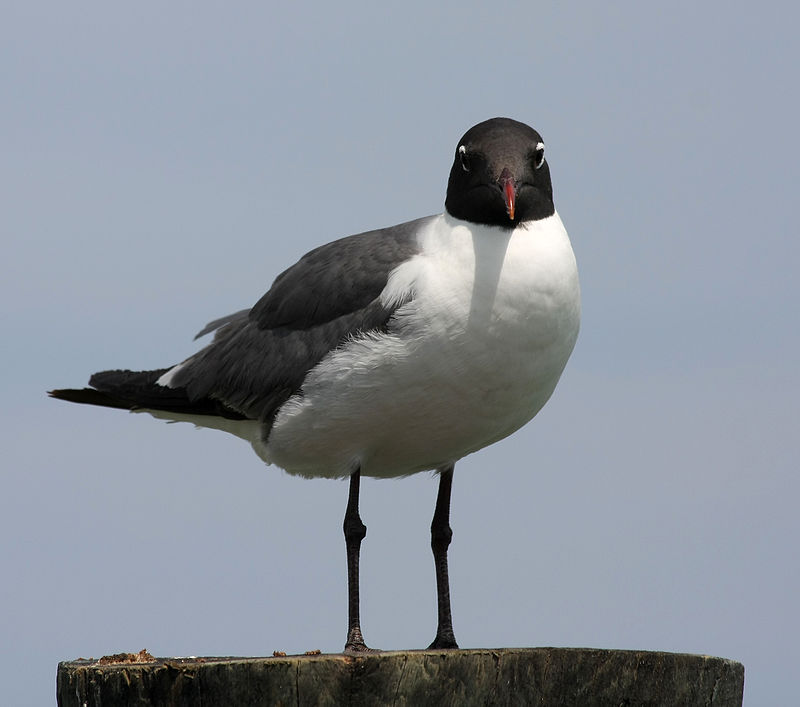
The Laughing Gull is a medium-sized bird with gray wings, black head and white underparts. It has bright red legs and bill which make it easily distinguishable from other gulls.
The name comes from its unique laughing call which can be heard in coastal areas throughout the Americas where they breed. They are opportunistic omnivores that feed on fish, carrion, insects or even garbage when available.
During breeding season these birds form large colonies along the Atlantic coast of North America as well as parts of northern South America and Caribbean islands.
There are two subspecies; L megalopturus found in Canada to Central America while L atricilla inhabits rest of their range..
These species have become more common inland due to human settlement near coasts creating ideal habitat for them but also making them scavengers around urban areas.Scientific classification:
| Kingdom | Animalia |
| Phylum | Chordata |
| Class | Aves |
| Order | Charadriiformes |
| Family | Laridae |
| Genus | Leucophaeus |
| Species | L. atricilla |
43. California Gull
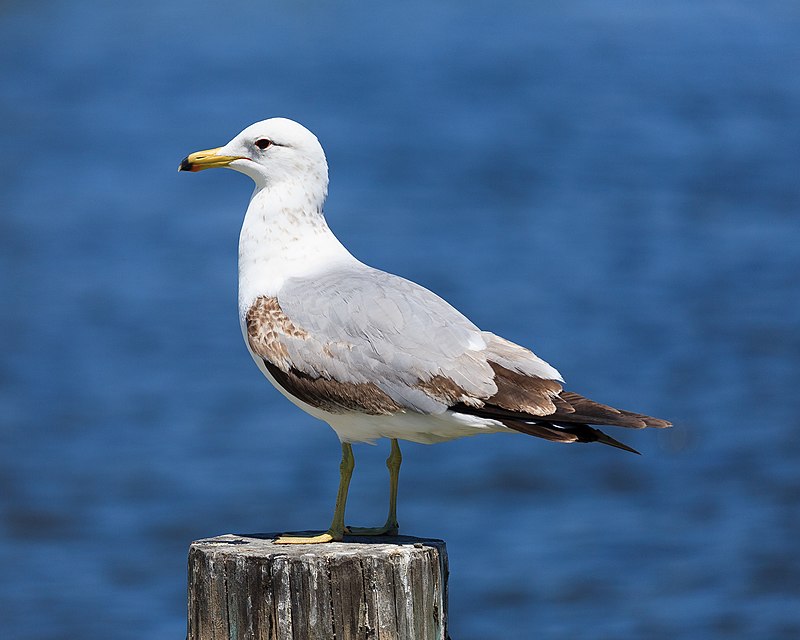
The California Gull is a medium-sized bird, smaller than the herring gull but larger than the ring-billed gull. It has a yellow bill with black ring and yellow legs.
Its head is rounder compared to other gulls and its body mainly white in color with grey back and wings.
They are mostly found around lakes, rivers or coasts of western North America where there is plenty of food available for them such as fish, insects and crustaceans which they consume on their daily diet.
During breeding season these birds form large colonies near water bodies or wetlands where they also make their nests using grasses sticks or feathers.
As omnivores they play an important role in maintaining balance within local ecosystems by eating both plants material like seeds & fruits as well as small mammals like rodents.Scientific classification:
| Kingdom | Animalia |
| Phylum | Chordata |
| Class | Aves |
| Order | Charadriiformes |
| Family | Laridae |
| Genus | Larus |
| Species | L. californicus |
44. Snowy-Crowned Tern

The Snowy-crowned Tern is a species of tern found in South America. It has white plumage with a grey back, and its distinguishing feature is the black crown on its head which gives it its name.
They inhabit swamps, shallow seas and intertidal marshes where they feed mainly on small fish and insects.
This species was first described by John James Audubon in 1838 from specimens collected around the Rio de la Plata estuary between Argentina and Uruguay.
Although not considered threatened overall, their conservation status varies depending on region; for example in Brazil their population is decreasing due to habitat loss caused by urban expansion or intensive agriculture activities near wetlands areas that are home to this bird species.Scientific classification:
| Kingdom | Animalia |
| Phylum | Chordata |
| Class | Aves |
| Order | Charadriiformes |
| Family | Laridae |
| Genus | Sterna |
| Species | S. trudeaui |
45. Fairy Tern
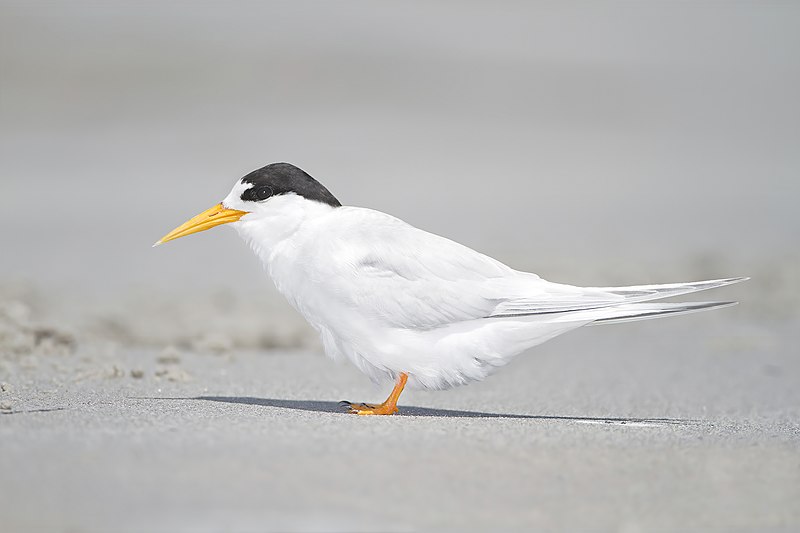
The Fairy Tern is a small tern native to the southwestern Pacific and listed as “Vulnerable” by the IUCN, with its New Zealand subspecies declared critically endangered.
The bird has a white body, light bluish-grey wings, and a black patch which does not extend further than their eye but not quite as far as their bill.
During mating season they develop an attractive breeding plumage of yellow breast feathers and grey legs.
They are able to fly long distances in search for food or migrate during winter months when available resources may be scarce in certain areas.
Despite this amazing ability to adapt however, human activities such as coastal development have caused severe population decline making them highly vulnerable species at risk of extinction without conservation efforts soon being implemented.Scientific classification:
| Kingdom | Animalia |
| Phylum | Chordata |
| Class | Aves |
| Order | Charadriiformes |
| Family | Laridae |
| Genus | Sternula |
| Species | S. nereis |
Also Featured In: South Australian Birds, Most Common Western Australia Birds
46. Yellow-Billed Tern
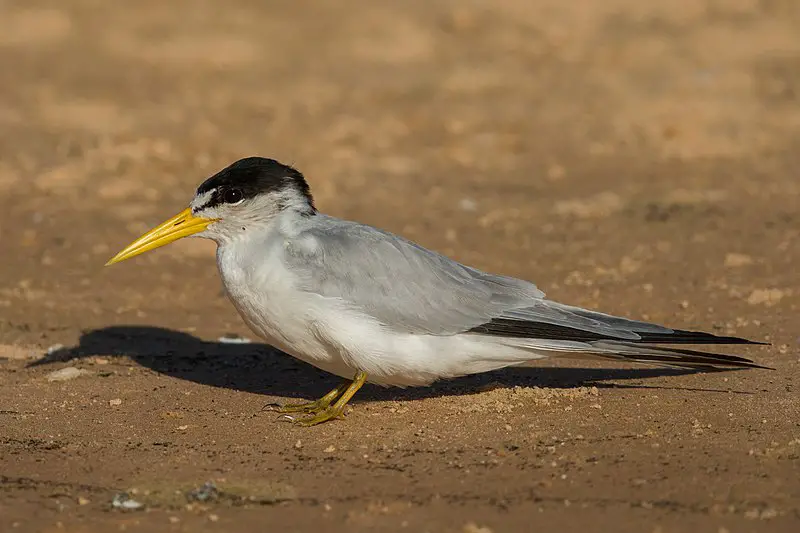
The Yellow-billed Tern is a small seabird native to South America. It has bright yellow bill and can be found in countries such as Argentina, Bolivia, Brazil, Colombia, Ecuador and more.
This species of tern loves rivers but it also enjoys swamps or freshwater lakes just the same.
The size of these birds range from 23-25 cm which makes them appear quite petite compared to some other bird species out there.
Although they are not ground nesters like many other types of terns they do still prefer nesting near water so that their chicks can have easy access when learning how to fly for the first time.
All in all this cheerful little bird is sure to bring joy with its colourful plumage wherever it goes.Scientific classification:
| Kingdom | Animalia |
| Phylum | Chordata |
| Class | Aves |
| Order | Charadriiformes |
| Family | Laridae |
| Genus | Sternula |
| Species | S. superciliaris |
47. Inca Tern
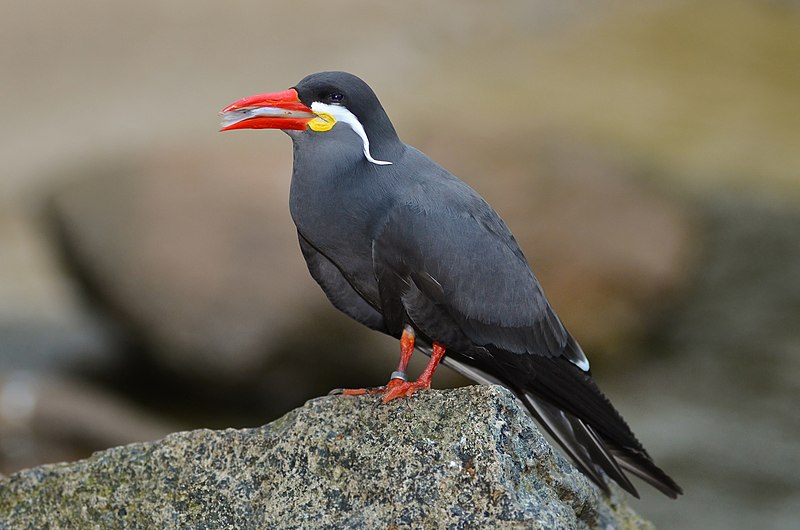
The Inca tern, found exclusively in the Humboldt Current on Peru and Chile’s coasts is a striking bird of uncommon beauty.
It has unique plumage that sets it apart from other birds in its family Laridae.
Recently, a single individual was seen making an unexpected appearance at Hawaii’s Big Island and Oahu shores – an occurrence that had previously been unheard of.
They are also known to make rare visits to Ecuadorian southwest coast too.
A graceful flyer with elegant wingspans, the Inca tern is truly remarkable for its unusual characteristics – one worth seeing if you ever get the chance.Scientific classification:
| Kingdom | Animalia |
| Phylum | Chordata |
| Class | Aves |
| Order | Charadriiformes |
| Family | Laridae |
| Genus | Larosterna Blyth, 1852 |
| Species | L. inca |
48. Spectacled Tern
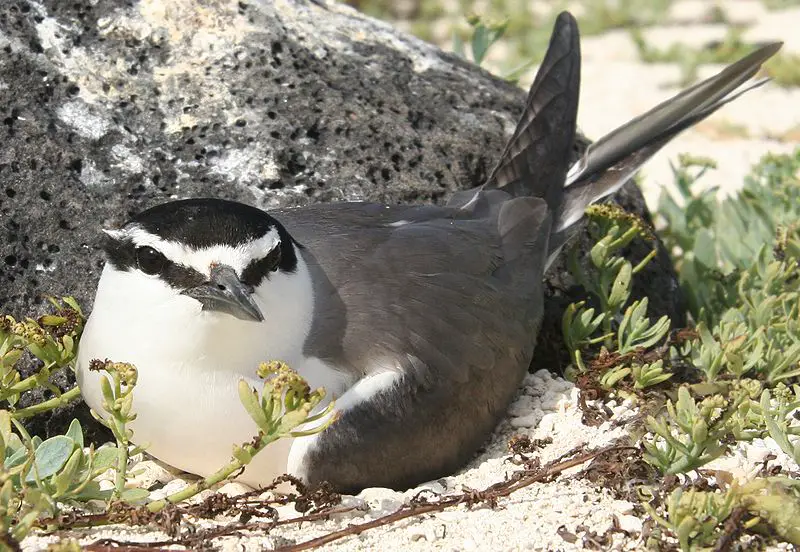
The Spectacled Tern is a beautiful seabird that belongs to the Laridae family. It has distinct grey wings and white head with black markings around its eyes, which give it the appearance of wearing glasses, hence its name.
This species is closely related to Bridled and Sooty terns, but less common than them due to low population numbers.
Recently they were split into their own genus Onychoprion along with Aleutian tern.
They are found in coastal areas such as tropical islands or coral reefs where they breed during summer months before migrating further south for winter season.
These birds feed on small fish by diving from great heights into water bodies like lakes or oceans making them an interesting sight when seen up close.Scientific classification:
| Kingdom | Animalia |
| Phylum | Chordata |
| Class | Aves |
| Order | Charadriiformes |
| Family | Laridae |
| Genus | Onychoprion |
| Species | O. lunatus |
49. Kerguelen Tern
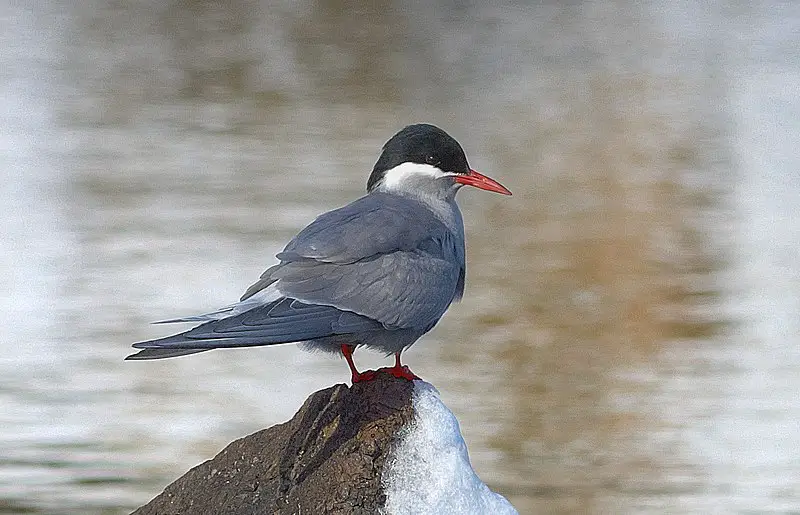
The Kerguelen tern (Sterna virgata) is a species of seabird found in the southern hemisphere.
It breeds colonially, primarily on the Kerguelen Islands but also has smaller colonies at the Prince Edward and Marion Islands as well as Crozet Islands.
Estimates put their total population between 3,500 to 6,500 birds with no recent data from their main colony site.
They have slate grey upperparts and white underparts that are streaked black along its sides while its head is pale grey with a faint dark cap.
The beak and legs are yellowish-brown in coloration giving it an overall handsome look which makes it stand out amongst other terns of similar size.Scientific classification:
| Kingdom | Animalia |
| Phylum | Chordata |
| Class | Aves |
| Order | Charadriiformes |
| Family | Laridae |
| Genus | Sterna |
| Species | S. virgata |
50. Bonaparte’s Gull
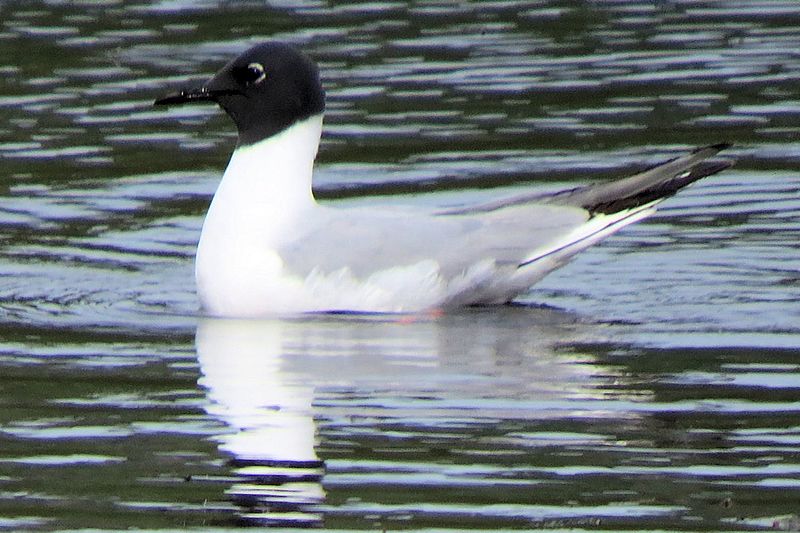
Bonaparte’s gull is a small species of gull usually found in northern North America. It measures 28 to 38 cm (11 to 15 inches) long and has mainly white plumage with grey upperparts.
During breeding season, it develops a slaty-black hood on its head. Both male and female Bonaparte’s gulls look alike; they are not sexually dimorphic like some other birds.
This bird was first described by George Ord in 1818, although Native Americans had likely been familiar with the bird for much longer than that.
Its scientific name Chroicocephalus philadelphia means “grey headed Philadelphia” due to its resemblance to the city’s official bird – the American Bald Eagle.
The bonaparte’s Gull is an active hunter which feeds mostly on insects and invertebrates as well as fish eggs or larvae when available.
Despite their size, these birds can often be seen flying far away from shorelines over open water looking for food.Scientific classification:
| Kingdom | Animalia |
| Phylum | Chordata |
| Class | Aves |
| Order | Charadriiformes |
| Family | Laridae |
| Genus | Chroicocephalus |
| Species | C. philadelphia |